

Utah National Parks Road Trip Itinerary: How to Plan a 7-Day Trip to the Mighty 5 in 2024
Planning a Utah national parks road trip? I’ve got the ultimate Utah itinerary, based on my own travels in this beautiful state. And to make your planning easier, I’ve even included a handy downloadable trip planner!
With five national parks to explore, hiking trails galore and some epic scenery, a Utah national parks road trip is something you’ll never forget.
Hitting the so-called Mighty 5 – Utah’s five national parks of Zion, Bryce Canyon, Arches, Canyonlands and Capitol Reef – is possible in just a week, and you won’t believe how different and beautiful each national park is .
Here I’m sharing the Utah road trip itinerary my husband and I took. This itinerary allowed us to see the Mighty 5 in just seven days – and we even snuck in a quick side trip to Arizona .
This is one of my favourite adventures of all time in the United States, so here’s how you can follow the Utah itinerary we took.
I’ve even created a printable planner so that you can plot out your own Utah national parks road trip itinerary, so download a copy here .
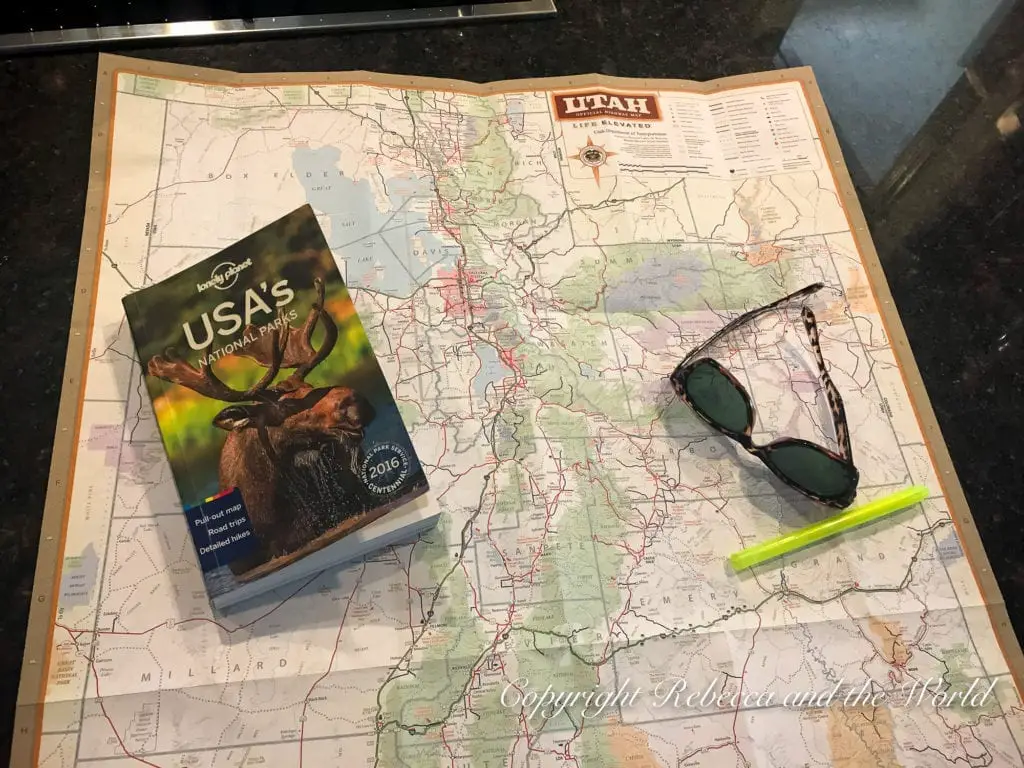
This blog post may contain affiliate links, meaning if you book or buy something through one of these links, I may earn a small commission (at no extra cost to you).
How to do this Utah road trip
This is a road trip, so of course you’ll need your own wheels . You have a few options here:
- Rent a car through Discover Cars and either camp or stay at hotels/Airbnbs along the way.
- Rent a campervan or RV – this is what we did and it made the trip even more fun! You’ll combine your transport and accommodation costs, saving some dollars as well. RVShare is a good option for this; it’s like the Airbnb of RVs. Escape Campervans is another great option for campervan rentals. I’ve listed campground throughout this post and you can use apps like iOverlander or US Public Lands to find free campsites .
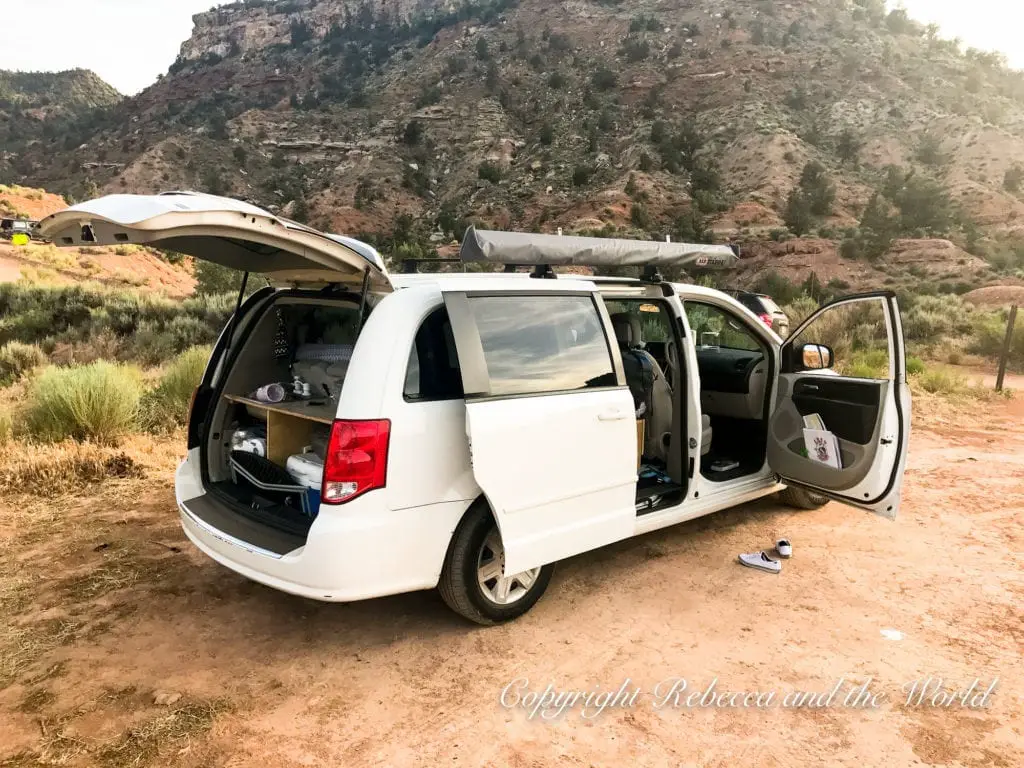
A question I get asked: Do you need a 4×4 for this road trip? If you follow this itinerary, you won’t need a 4×4 – a regular car is perfectly fine. The roads are all sealed and well maintained. Of course, you won’t be able to get out to some of the backroad locations – but you probably wouldn’t have time to do that in this short itinerary anyway.
Utah Mighty 5 road trip routes
To do this bucket list USA Utah national parks road trip, I’d recommend at least a week . This itinerary will give you a day in each park (two days in some parks) so there isn’t a lot of room for downtime.
If you have 10 days or two weeks to road trip Utah’s national parks, that would be even better. This will allow you to really explore all the natural beauty this state has to offer.
There are several ways you can visit all five Utah national parks in a week , depending on where you’re starting from. The best places to start and end this trip is in Las Vegas or Salt Lake City .
We did option number 1, but if I was doing this trip again, I’d probably take the Las Vegas to Salt Lake City (or vice versa) route to save on a bit of backtracking.
For option #2, check that your rental company allows you to return a vehicle to another location (there may be an additional charge).
For option #3, you could even add in a side trip to the Grand Canyon if you have one or two extra days.
These three Utah road trip route options include a side trip into Arizona to Monument Valley. But if you’re short on time, you can cut this out of your Utah itinerary.
National parks road trip itinerary
As mentioned earlier, we did a loop starting and ending in Salt Lake City , so that’s what I’ll get into in this article. You can easily take the information here and adapt it to the alternative routes listed above.
This 7-day Utah road trip itinerary that loops from Salt Lake City is:
Day 1: Salt Lake City to Zion National Park
Day 2: zion national park, day 3: bryce canyon national park, day 4: monument valley.
- Day 5: Canyonlands National Park and Moab
- Day 6: Arches National Park and Canyonlands National Park
- Day 7: Back to Salt Lake City via Capitol Reef National Park
Map of Utah national parks
Before I get into the nitty gritty of the Utah national parks road trip itinerary, here’s a map of where you’ll be going if you follow the route we took. You can download a map of national parks in Utah on the Visit Utah website or they’ll even post one to you if you plan ahead.
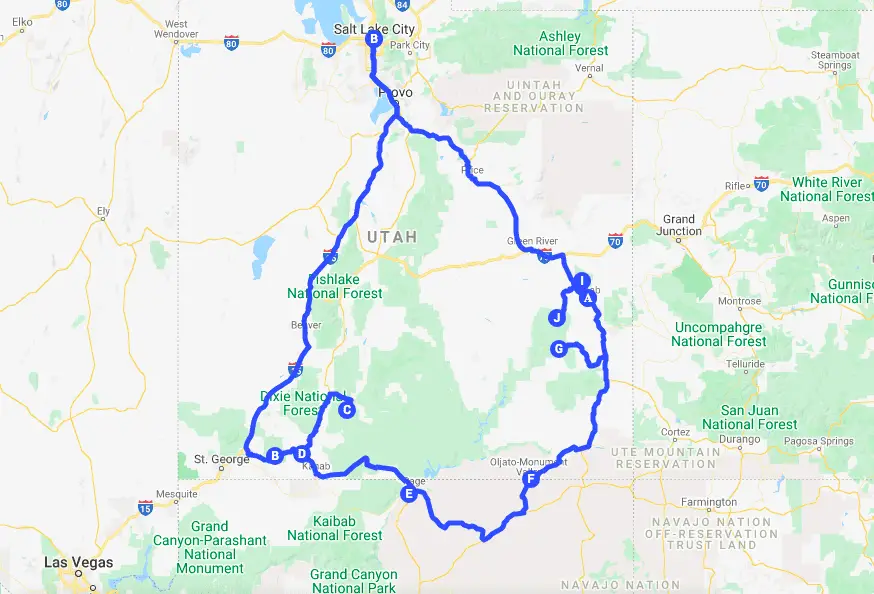
Alright, it’s time to hit the road!
Driving time: 4.5 hours / 308 miles
First up on this 7 day Utah national parks itinerary: pick up your car or campervan . Pick up any supplies you may need (including plenty of road trip snacks!). I have a handy road trip checklist so you don’t forget anything important.
You could check out of a few of the best things to do in Salt Lake City , but I’d recommend jumping straight on the road and heading for Zion National Park . It’s about a 4.5-hour drive from Salt Lake City.
Zion National Park is the busiest Utah national park , with more than 5 million visitors. Despite the crowds, it’s a must-visit on a Utah parks road trip.
Springdale is the town just outside of the entrance to Zion, and it has several great options for your first dinner on the road.
Zion National Park quick reference guide
Entrances: The main entrance is the South Entrance, near the town of Springdale Entrance fee: Private Vehicle, $35, valid for 7 days Website: Zion National Park Tips: Access to cars through the park is limited during high season (March to November), but Zion National Park has a fantastic free shuttle bus system to get around. The shuttle stops at all the key trailheads and loops around fairly frequently.
There’s also a shuttle bus that links to the Zion Canyon Shuttle from Springdale, which is convenient if you’re staying in town.
Where to stay in Zion National Park
Zion national park campgrounds.
Zion National Park has three campgrounds : South, Watchman and Lava Point. You can reserve South and Watchman in advance (campsites are $20 per night, $30 for powered sites at Watchman). South Campground can be reserved up to 14 days in advance, while Watchman can be reserved up to 6 months ahead of time. (Update: As of December 2023, South Campground is partially closed for rehabilitation works.)
If you can’t get a reservation in advance, you can still plan to arrive at the campgrounds at around 10 or 11am just in case a site becomes available. That’s how we got a site for the night.
Lava Point only has six basic campsites and is more remote, with no cell reception. Reservations can be made online. It’s open May to September only.
Hotels near Zion National Park
- Zion Lodge is the only hotel inside Zion National Park
- For something partway between a hotel and camping, try the luxury, safari-style tents at Under Canvas Zion
- Cliffrose Lodge is close to the entrance to Zion National Park
- Best Western Plus Zion Canyon Inn & Suites has comfy rooms with mini fridges and coffee makers – and great views
Vacation rentals near Zion National Park
If you can’t get a hotel room, plan ahead and look at vacation rentals instead. VRBO has several options to suit all group sizes and budgets. Check vacation rentals near Zion National Park .
Wake up early (I’m talking, like, 5am) to get a head start on the Angel’s Landing hike . This hike is very popular on most people’s Zion national park itinerary, and starting early helps to avoid both the crowds and the heat of the day. It’s a beautiful but fairly strenuous hike with some pockets of shade.
The final ascent to Angel’s Landing is a narrow ridge with steel chains as the only barrier to keep you falling hundreds of metres off the side.
I’m not shy in admitting that I just couldn’t bring myself to do this final section – it was too scary for me. I stayed below while my husband did the final section. He said that it was hairy in some parts, but the views are worth it if you don’t have a fear of heights .
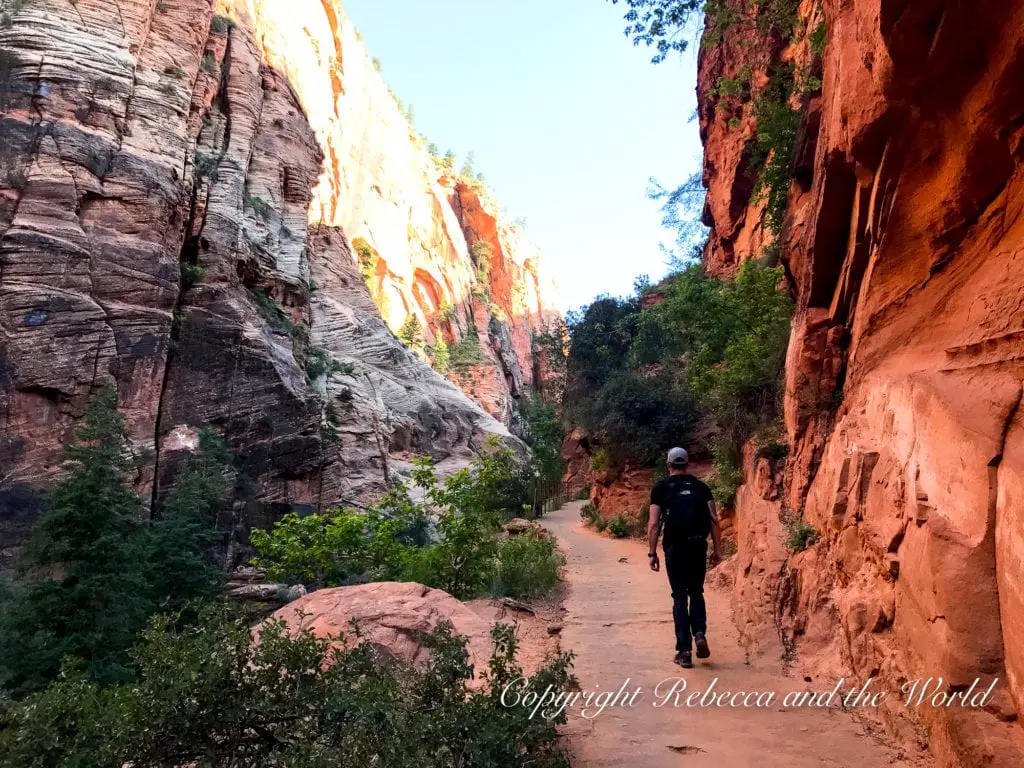
Later in the afternoon, take off on your next hike along the Riverside Walk .
If you can brave the icy water, end the day by wading through the start of The Narrows hike . We only did a small portion of this, and I would love to come back and do it completely. You can hike as far as Big Spring without a permit. It’s a 10-mile round-trip, so you’ll need the whole day to tackle this.
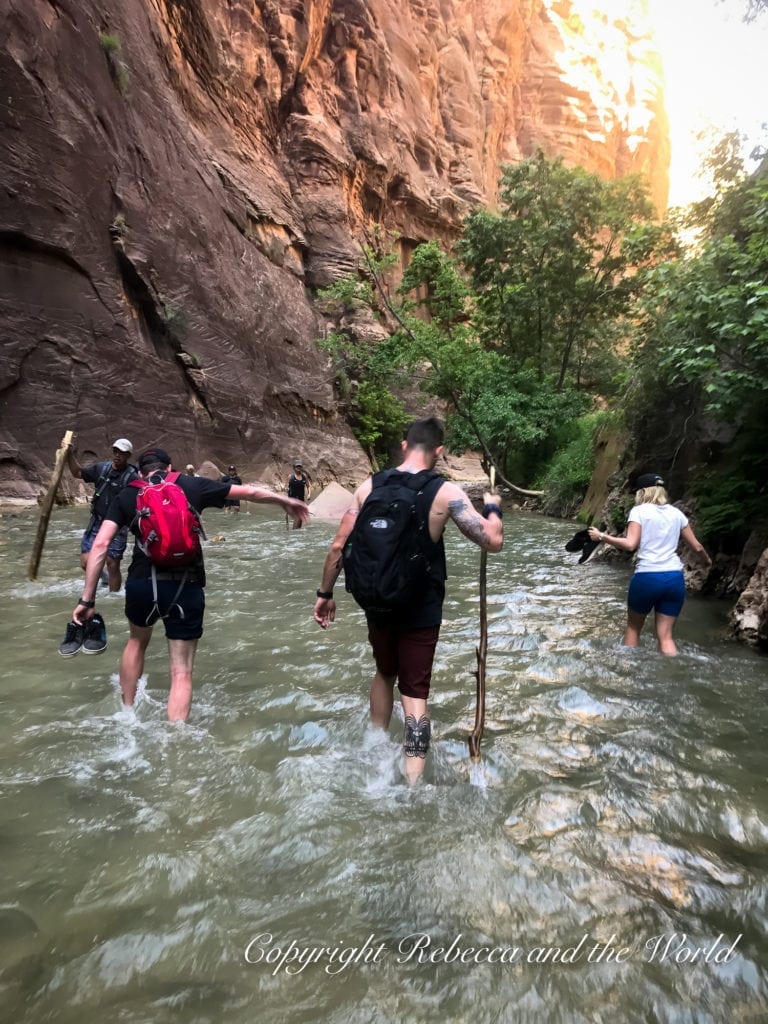
Best hikes in Zion National Park
- Angel’s Landing (5.4 miles, strenuous)
- Observation Point (8 miles, strenuous)
- Canyon Overlook Trail (1 mile, moderate; easier alternative to Angel’s Landing)
- Riverside Walk (2.2 miles, easy)
- Weeping Rock Trail (0.4 miles, easy)
- The Narrows (10 miles (to Big Spring) return trip, strenuous; high water levels and the risk of flash flooding can mean this is closed at some times during the year)
Driving time: 1.5 hours / 75 miles
Leaving Zion National Park on your way to Bryce Canyon , traverse the scenic 12-mile Zion-Mt Carmel Highway , passing through the historic tunnel. It’s a beautiful, winding road that exposes the red rocks of Zion.
It’s time to see just how different Bryce Canyon National Park, with its orange and white hoodoos , is to the deep red rocks of Zion National Park.
In my opinion, Bryce Canyon is the best national park in Utah . The landscape is out of this world and when we visited it was far quieter than Zion.
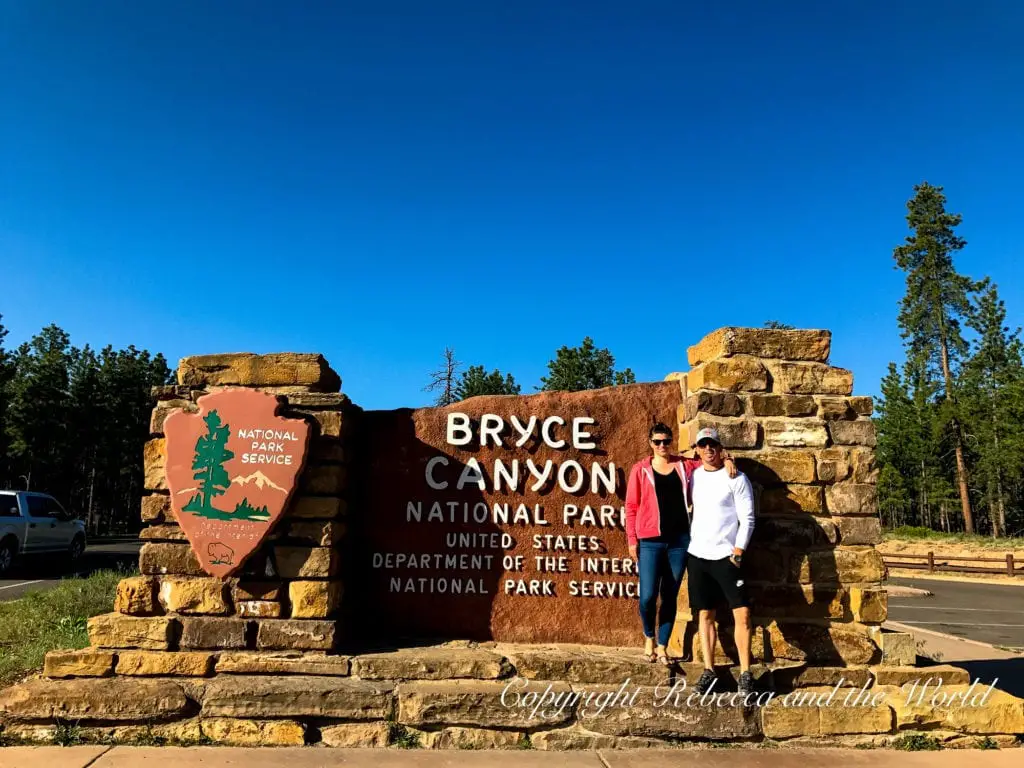
Hike the Navajo Loop / Queen’s Garden trails which take you down into and back up the canyon and past Thor’s Hammer . Later, hike a section of the Rim Trail , and stand above the hoodoos to get an idea of what Mars surely must look like.
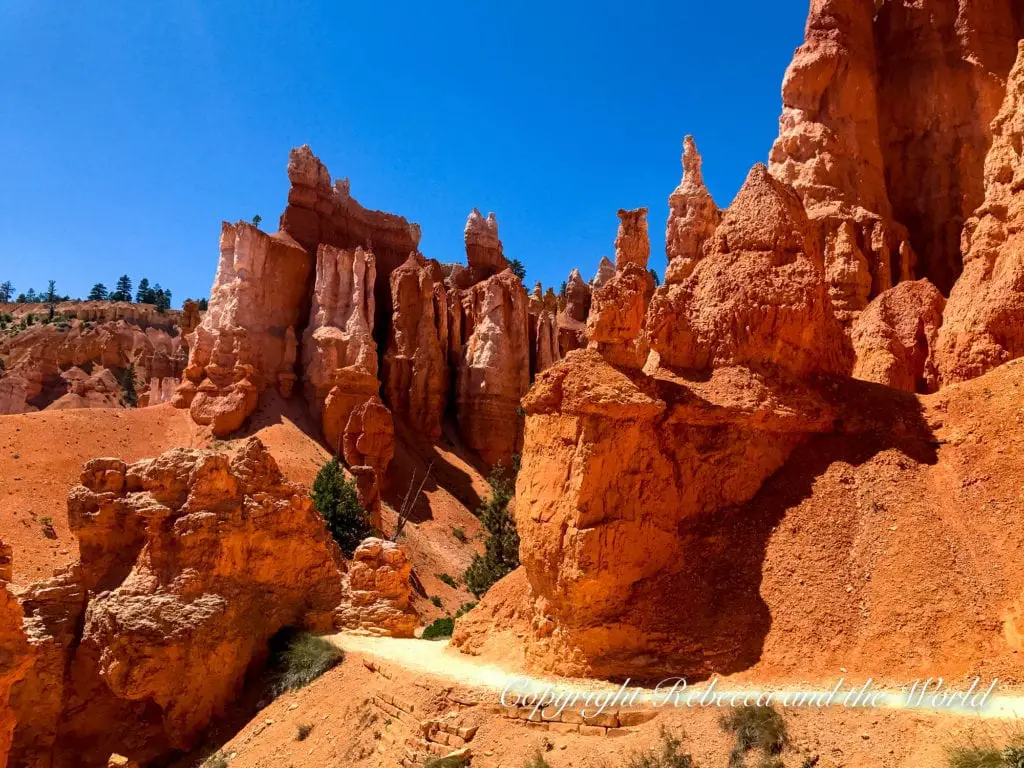
Sunset at Inspiration Point is a must, watching the colours of the hoodoos change as the sun goes down.
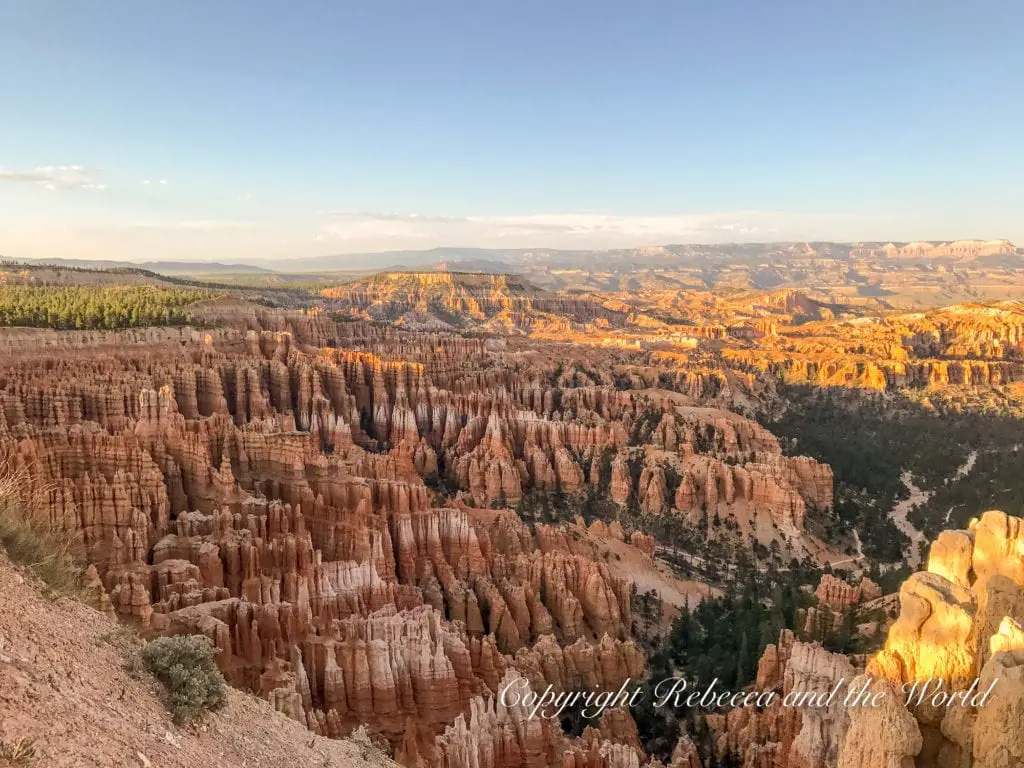
Best hikes in Bryce Canyon National Park
- Navajo Loop / Queen’s Garden (2.9 miles combined, moderate)
- Rim Trail (up to 11 miles, easy; paved from Sunset to Sunrise Points)
- Fairyland Loop (8 miles, strenuous)
Bryce Canyon National Park quick reference guide
Entrances: The only entrance to the park is via UT 12; you’ll pass through the small town of Bryce Entrance fee: Private Vehicle, $35, valid for 7 days Website: Bryce Canyon National Park Tips: Visitors are encouraged to take advantage of the free shuttle bus that operates through the park
Where to stay in Bryce Canyon National Park
Bryce canyon national park campgrounds.
There are two campgrounds in Bryce Canyon: North Campground and Sunset Campground (sites $30 per night). Both are close to the visitor centre.
Campsites at both campground can be reserved between mid-May and early October. For the rest of the year, they operate on a first-come, first-served system.
Outside of Bryce Canyon, Ruby’s Inn has an RV park and campground, which is where we stayed.
Hotels near Bryce Canyon National Park
If you’re not camping, try one of the hotels near Bryce Canyon National Park .
- Ruby’s Inn Best Western Plus is a popular option outside Bryce Canyon National Park (we stayed at the adjoined RV park and campground)
- The Lodge at Bryce Canyon is located inside the park, with 114 rooms and an on-site restaurant
- Stone Canyon Inn has several cabins onsite
Vacation rentals near Bryce Canyon National Park
- This charming country home on a large property – with fruit picking available in the fall
- This incredible chalet halfway between Zion and Bryce Canyon National Parks
Driving time: 4.5 hours / 275 miles
On day four of the Utah national parks road trip, we’re actually heading into another state: Arizona !
As I mentioned earlier, you can skip Monument Valley if you want to stay in Utah and spend more time at the Mighty 5 national parks. But it’s a great detour.
It’s a long day of driving from Bryce Canyon south into Arizona. Stop for pie at the retro Thunderbird Restaurant at Mt Carmel Junction. As an Australian, this place is exactly how I always pictured American diners to be!
Stop at Page , home to the highly Instagrammed Horseshoe Bend , and nervously watch everyone as they perch on the edge to get the perfect selfie.
It’s a hot and dusty walk to the viewpoint, so bring adequate shoes and lots of water and sunscreen . To manage the huge influx of visitors that Horseshoe Bend has recently experienced, you’ll now need to pay an entrance fee of $30 per passenger vehicle.
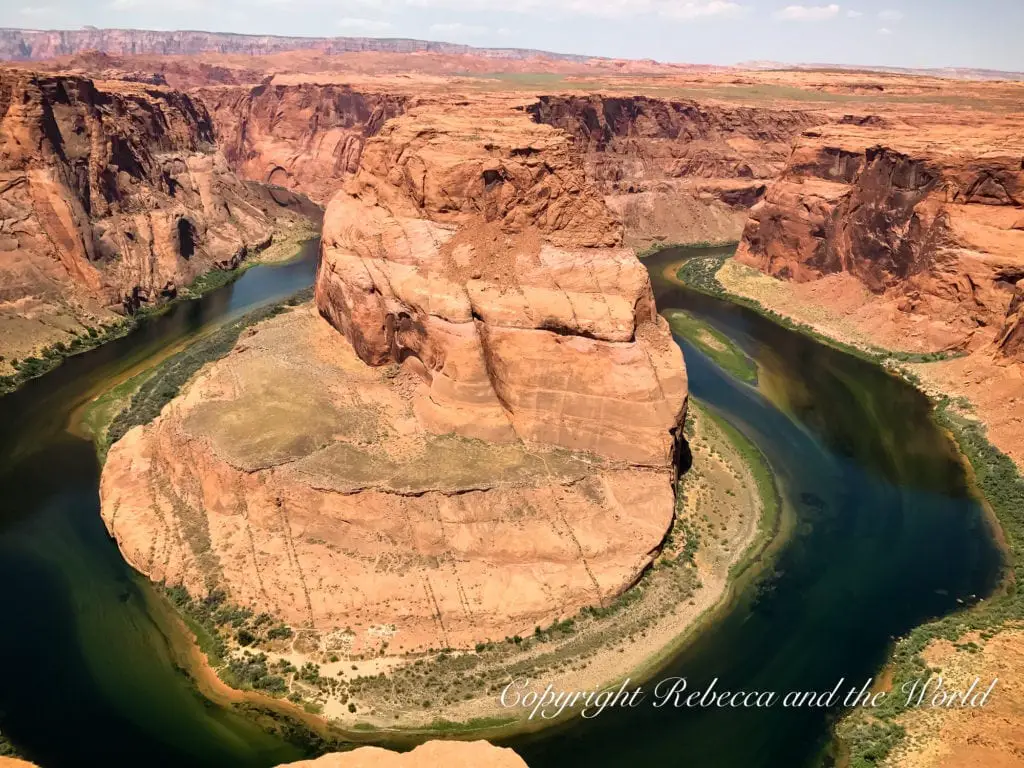
Another popular site in Page is Antelope Canyon . Here you can visit Upper Antelope Canyon, an incredible slot canyon. Reservations are a must. We unfortunately didn’t have time, but photos I have seen are spectacular. If you can make the time, there are tours of Lower Antelope Canyon and Upper Canyon .
If you have even more time, many people add on a trip to the Grand Canyon to their Utah national parks road trip itinerary. You’ll need at least two days, though, to see the park properly.
Continue on to Monument Valley , famous from oh-so-many movies. Drive through the valley ($8 per person, per day; Monument Valley isn’t covered under the America the Beautiful national parks annual pass ) in the late afternoon as the sun is going down for some spectacular silhouettes of the buttes . Early morning is another option for nice light.
You need two to three hours to do the 17-mile self-guided driving tour through Monument Valley (maps available at the Information Center).
There are a few hiking trails (permit required) or you can take an organised tour which will allow you access to a traditional Navajo hogan, a small house. Here’s a good option for a sunset tour , or a 2.5-hour trip with backcountry access where you’ll learn more about Navajo culture.
Be respectful of the land at all times and stick to the trails – this is Navajo land .
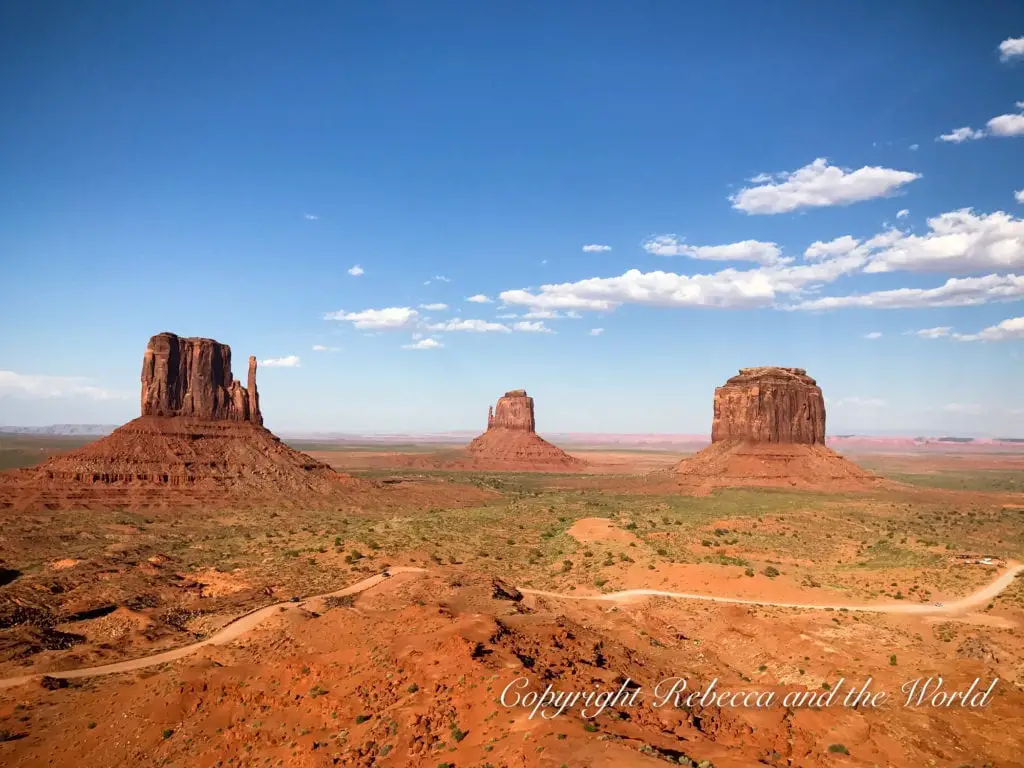
Hotels near Monument Valley
There are a couple of hotels near Monument Valley :
- We parked our campervan at Goulding’s Lodge , which has both a hotel and campground. It’s also got a restaurant, gas station, laundry, trading post and a museum highlighting the history of the area, including about the films that have been shot there. The theatre shows John Wayne movies nightly
- The View Hotel is located within Monument Valley Navajo Tribal Park. As the name suggests, it has great views over the valley
Day 5: The Needles, Canyonlands National Park
Driving time: 5.5 hours / 238 miles
Day five will see you heading back into Utah on your way to Moab . Before you get too far, stop at mile marker 13 on highway 163 for the classic road jumping shot with Monument Valley in the background.
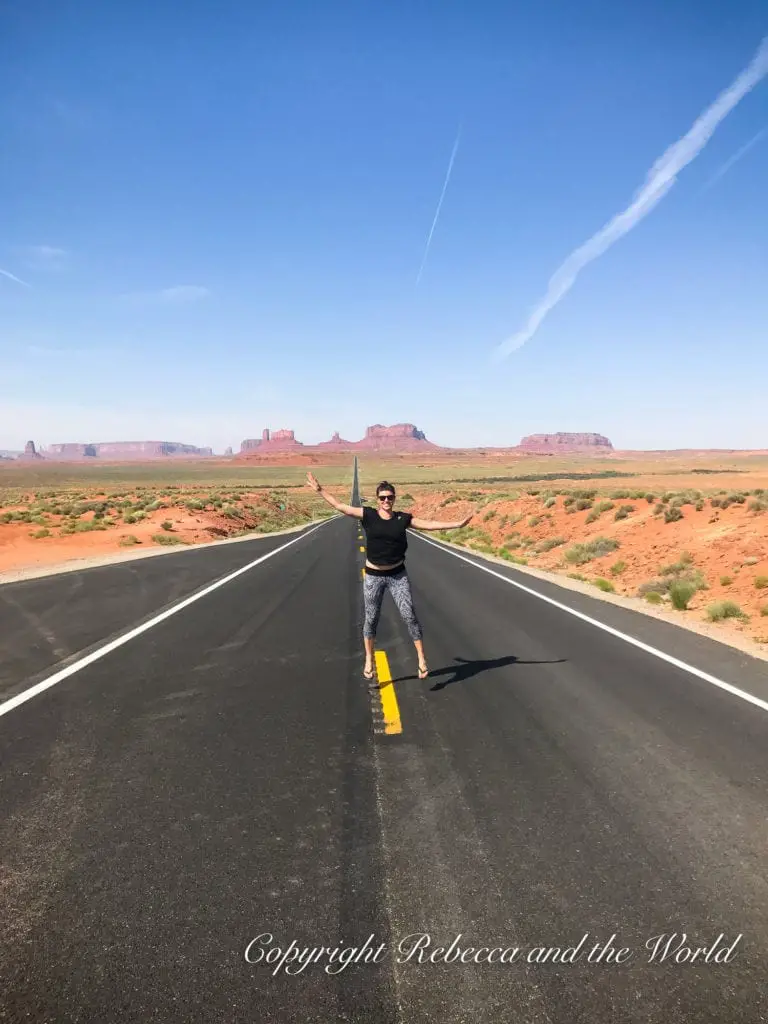
Before getting to Moab, take the long detour to The Needles area of Canyonlands National Park . It’s a side trip off the main road and does add extra time to this Utah road trip itinerary, but it’s worth it. If you’re short on time, then you can skip this and head straight to Moab.
Canyonlands National Park is actually split into three distinct areas by the rivers that run through the park: The Needles, Island in the Sky and the Maze. The Maze is only accessible by 4WD and is very remote. I haven’t included it in this Utah national parks itinerary because we didn’t visit it.
The Needles is far less touristy than the other national parks in Utah. To get a taste of the park, hike the Slickrock trail , which will take you over smooth, mustard-coloured rocks as you follow the cairns-marked trail.
After that, hit up another hike like the Cave Spring trail . This one winds through old cowboy hangouts and up ladders. Again, you’ll be marvelling at just how different the landscape is compared to the other national parks visited on this trip.
We only wish we’d had more time to do some of the longer, more challenging hikes. Unfortunately, there was a spectacular lightning storm starting up as we began hiking, and we didn’t want to be exposed.
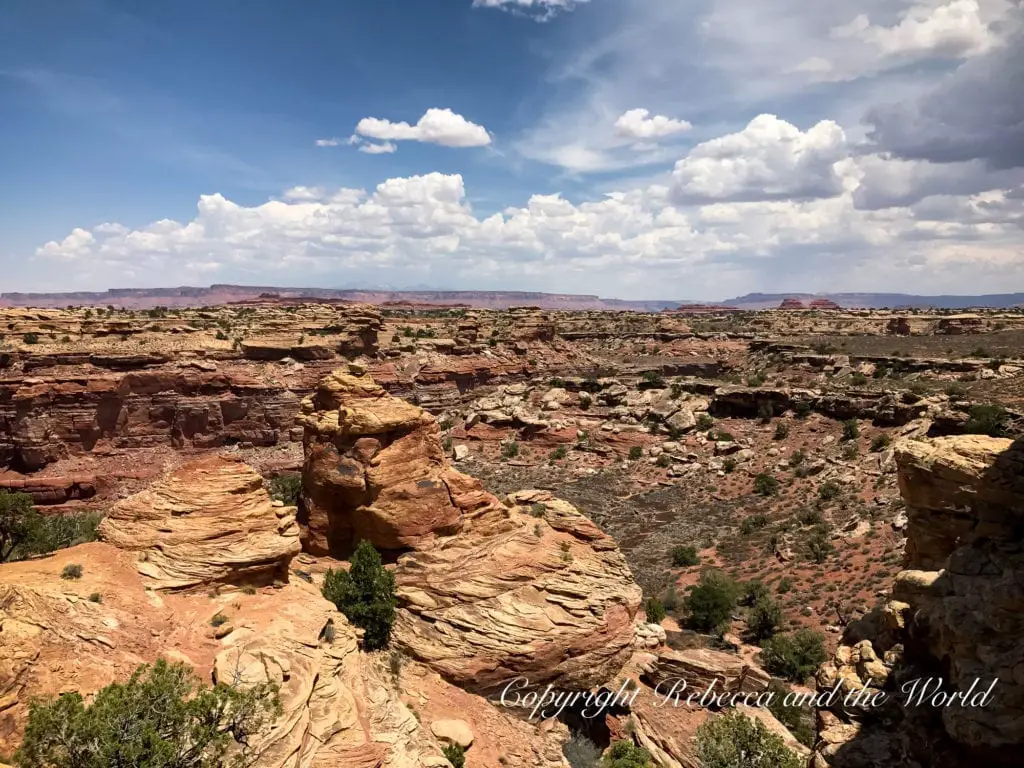
Continue on to Moab and have a late lunch of burgers and peanut butter milkshakes at Milt’s Stop and Eat .
Best hikes in The Needles, Canyonlands National Park
- Chesler Park Viewpoint (6 miles, strenuous)
- Slickrock Trail (2.4 miles, short)
- Big Spring Canyon to Squaw Canyon (7.5 miles, strenuous)
- Cave Spring (0.6 miles, short)
Canyonlands National Park quick reference guide
Entrances: The entrance to Island in the Sky is about 40 minutes from Moab, while The Needles entrance is about a 90-minute drive Entrance fee: Private Vehicle, $30 Website: Canyonlands National Park Tips: Moab is the best place to base yourself to see the two main sections of the park
Where to stay in Moab
Moab campgrounds.
- We stayed at the KOA campground in Moab . Staff were friendly and they have a pool and shop onsite.
Hotels in Moab
Moab is a small town, but its reputation as an action hub means that it’s full of hotels and campgrounds.
- The Gonzo Inn is a popular place to stay in Moab. There’s an outdoor pool which will be a huge relief in the heat of the afternoon – Moab gets really hot
- Red Cliffs Lodge has 115 simple rooms, some with balconies with great views over the river
Vacation rentals in Moab
There are plenty of vacation rentals in Moab , so you’ll have lots of choices. I like the look of:
- This light-filled cabin with a great patio with grill (and it’s dog friendly!)
- This property would be good for groups of up to 6 people
Day 6: Arches National Park and Island in the Sky
Arches National Park is just outside of Moab, and is famous for its variety of sandstone arches.
Tackle some of the shorter hikes to Broken Arch and Sand Dune Arch in the morning.
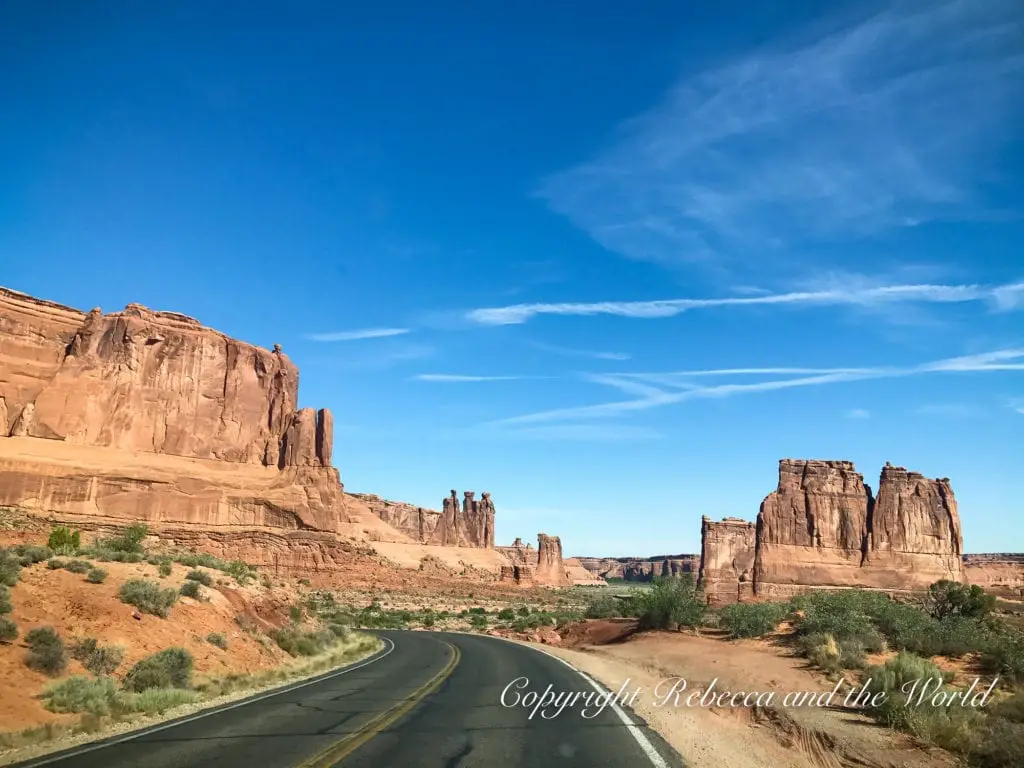
In the afternoon, hike to Delicate Arch . This is a must-do on your visit to Arches National Park. Be aware that this hike has no shade, and the last part is around a cliff face with a sharp drop off. It’s one of the most photographed spots on any trip to Utah.
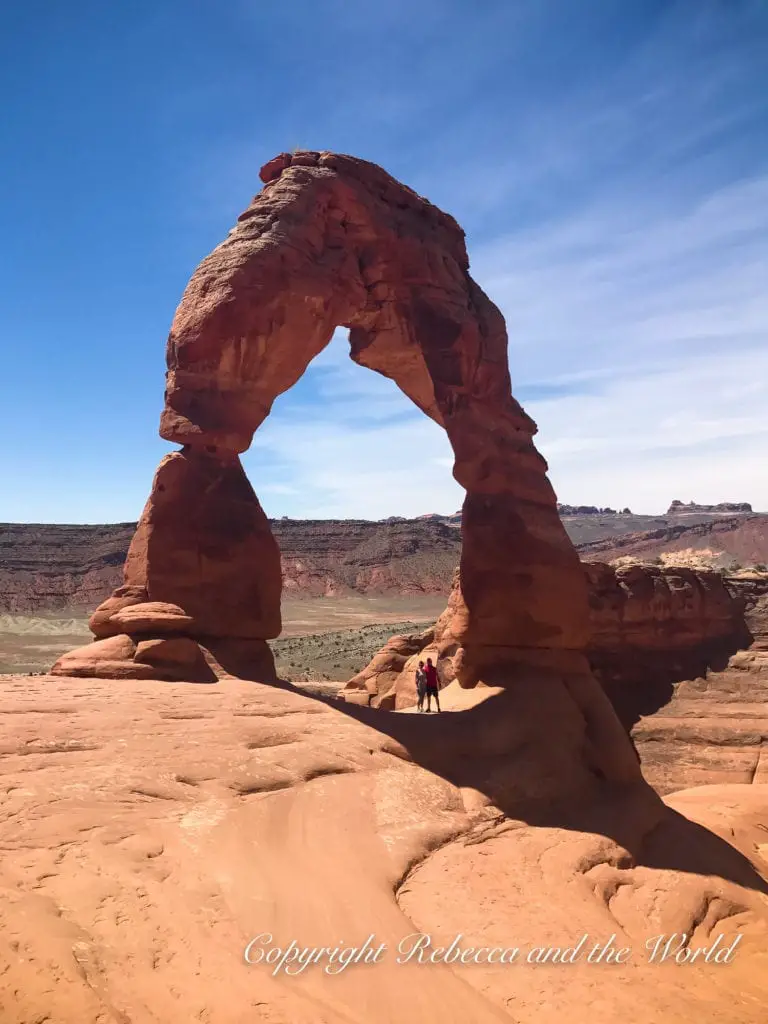
Best hikes in Arches National Park
- Delicate Arch (3 miles, strenuous)
- Double O Arch Trail (4.2 miles, strenuous)
- Park Avenue Trail (1 mile one-way, moderate)
- Devil’s Garden (7.2 miles, strenuous)
- Windows Trail (1 mile, easy)
- Fiery Furnace (reservation necessary, guided by Park Ranger)
Arches National Park quick reference guide
Entrances: The entrance is just a 10-minute drive from Moab Entrance fee: Private Vehicle, $30, valid for 7 days Reservation needed: Between 1 April and 31 October, you’ll also need to book a timed entrance. Book online here Website: Arches National Park
Before sunset, drive out to the other section of Canyonlands National Park, the Island in the Sky . From the viewpoint, gaze out over the land, which looks like a giant dinosaur has left its footprint behind.
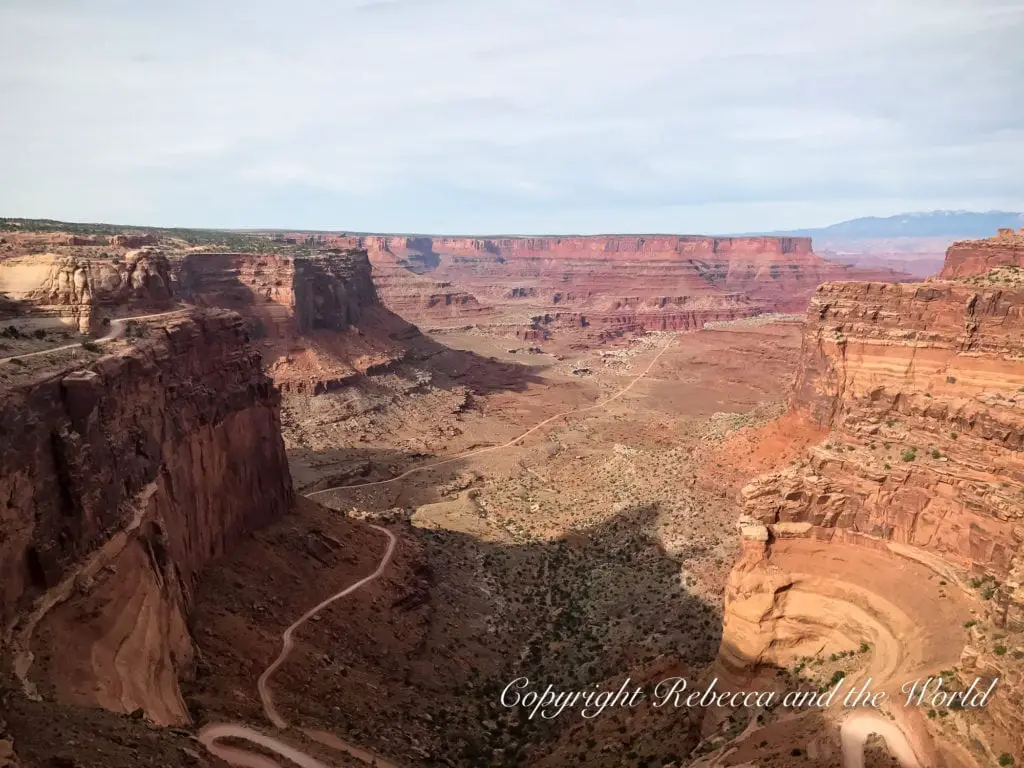
If you’re in luck, you might even have Mesa Arch all to yourselves for a few minutes. Most people recommend to visit Mesa Arch at dawn, but we found it to be just as beautiful at sunset.
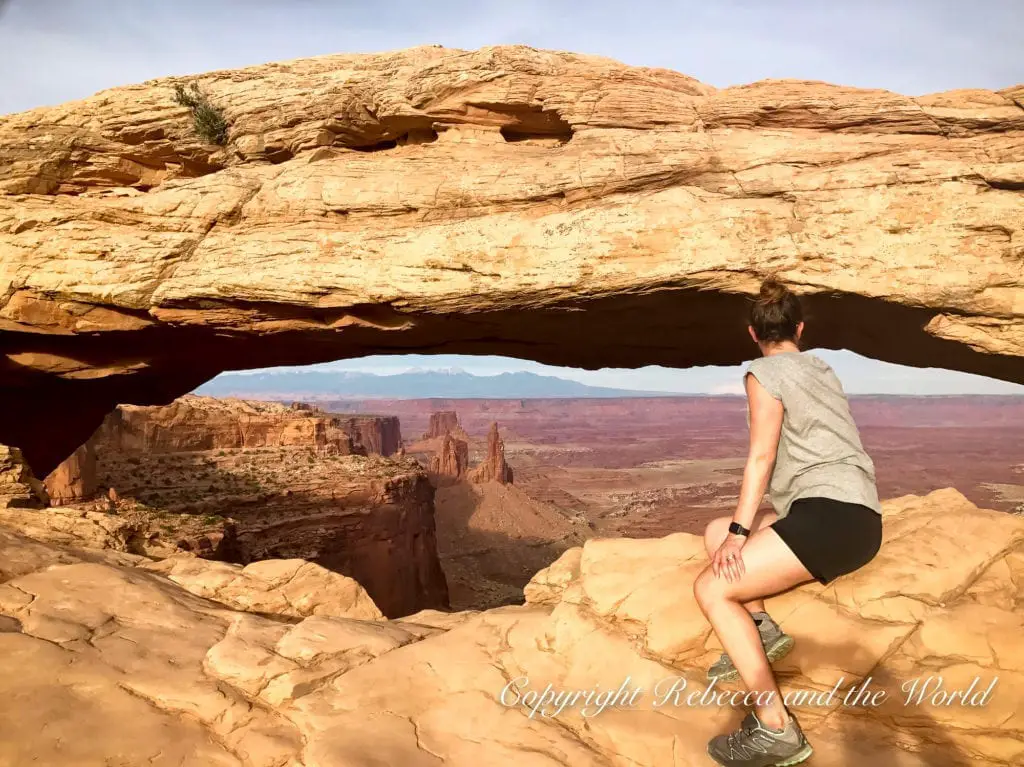
Moab is one of the best places to visit in Utah for adventure lovers , so if you’ve had enough of hiking, you can try mountain bike riding , offroading , 4×4 adventuring , rappeling or rafting on the Colorado River . There are companies throughout Moab that offer all sorts of outdoor adventures.
Best hikes in Island in the Sky, Canyonlands National Park
- Mesa Arch (0.5 miles, easy)
- Grand View Point Trail (2 miles, easy)
- Neck Spring (5.8 miles, moderate)
- Gooseberry Trail (5.4 miles, strenuous)
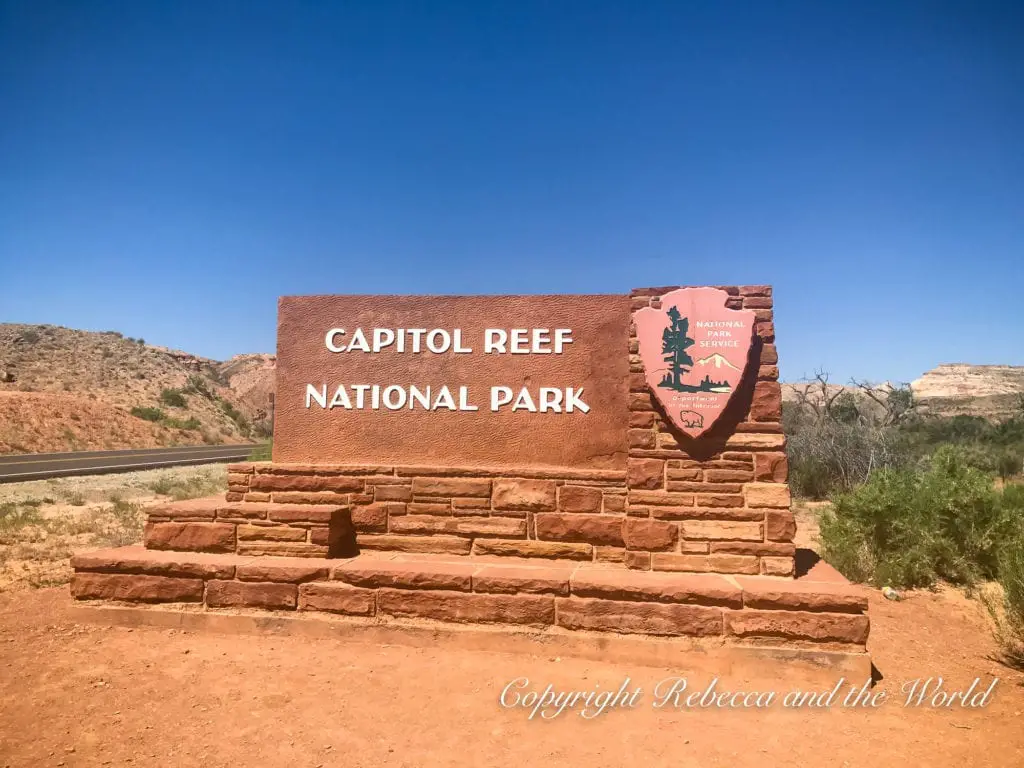
Day 7: Capitol Reef National Park and back to Salt Lake City
Driving time: 5.5 hours / 369 miles
On the last day of the road trip, return to Salt Lake City via Capitol Reef National Park .
As the smallest of the five Utah national parks , you can easily drive through it via the 9-mile scenic drive and stop off to do shorter hikes. We only spent a few hours here, the shortest visit of our trip.
The park also has an old Mormon mission and you can stop by the historic Gifford Homestead to enjoy a fruit pie in the shaded grounds. The perfect sweet way to finish your Utah national park itinerary!
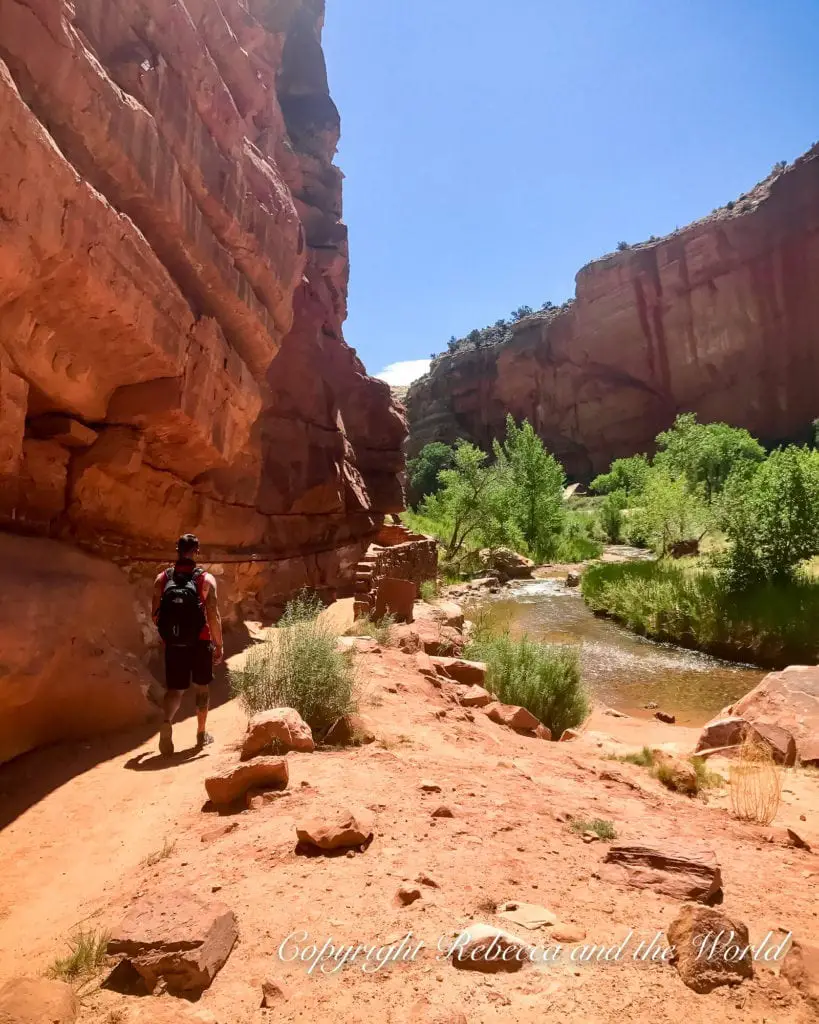
Best hikes in Capitol Reef National Park
- Sunset Point Trail (0.4 miles one-way, easy)
- Hickman Bridge Trail (0.9 miles one-way, moderate)
- Chimney Rock Trail (3.6 miles, strenuous)
- Rim Overlook Trail (2.3 miles, strenuous)
Capitol Reef National Park quick reference guide
Entrance fee: Private Vehicle, $20, valid for 7 days Website: Capitol Reef National Park
Where to stay near Capitol Reef National Park
If you do decide to stay longer than a few hours or one day, here are a few options for sleeping.
Capitol Reef National Park campgrounds
There’s only one developed campground within Capitol Reef, and that’s the 71-site Fruita Campground . The fee is $25 per night, and sites are reservable only between 1 March and 31 October. The rest of the year it’s first come, first served.
Hotels near Capitol Reef National Park
- For something truly unique, book a night in a Conestoga wagon! Peek out your wagon at Capitol Reef Resort in the morning for stunning red rock views. Or, choose from luxury teepees and cabins
- Broken Spur Inn and Steakhouse (located in Torrey) is a simple hotel only a 10-minute drive to the entrance of Capitol Reef National Park
Vacation rentals near Capitol Reef National Park
- This cute cabin is great for couples or small families
- This 2-bedroom home with a great deck in the nearby town of Teasdale
Finally, return your car or campervan in Salt Lake City – 7 days in Utah goes by quickly! This will be a trip you won’t quickly forget – and if you’re like me, you’ll be wanting to go back very soon.

Tips for planning a Utah national parks road trip itinerary
Buy a national parks pass.
If you’re planning to road trip to Utah national parks, buy the America the Beautiful annual pass , which costs $80. Each national park costs between $20 and $35 to visit, so if you visit three or more parks on this Utah mighty 5 road trip, this pass will save you money .
The pass is also valid at any national park in the entire United States so you can use it at other parks for the rest of the year.
Book accommodation in advance
Hotels, lodges and camping sites around the national parks can be booked out months – even a year – in advance, so book accommodation in advance . (I use Booking.com and Expedia to book accommodation, comparing prices across both sites before I book.)
Each campsite has different processes for booking. Some can be booked online in advance, others can only be booked in person on the day, so you’ll need to factor this in to your planning.
Research each park before you visit
Do your research on each park’s website in advance – there’s a huge amount of information available online. This will help you plan your days to get the most out of each park.
And when you arrive at each park, stop by the visitor centre to pick up a map and talk to the rangers . They know the best time to visit each location for the perfect photos and which hikes to do to maximise the time you have.
Best time to visit Utah national parks
We visited in early June and found it to be a great time to visit the Utah Mighty 5 – just before school vacation so the crowds were not quite in full force, and the weather was warm and sunny, but not yet suffocatingly hot.
Spring and autumn/fall
These are the best seasons to visit the national parks in Utah – but also the most popular. Temperatures are milder, so hikes will be more manageable, but you’ll have to battle the crowds.
It goes without saying that summer is the hottest time to visit the national parks of Utah, with temperatures often creeping toward 100 degrees Fahrenheit (40 degrees Celsius). If you must visit during these months, plan your visit carefully and aim to hike either early in the morning or late in the afternoon. And always have plenty of water with you.
The winter months can bring temperatures below freezing at night – and snow . I’ve seen photos of some of the national parks during winter and it looks stunning with snow-dusted peaks and few crowds, but make sure to come with adequate winter clothing.
What to pack for a Utah national parks road trip
When you’re visiting the national parks in Utah, come prepared. Here are a few items I’d recommend packing, and I have a longer road trip packing list guide with more ideas:
- An America the Beautiful annual pass to save you tonnes of money!
- A cell phone mount is helpful for hands-free navigating. Remember to download maps as you’ll encounter areas without service.
- Bring a good backpack for all your gear, and a daypack for hiking.
- Use a water bladder to stay hydrated while tackling the hiking trails.
- Pack sturdy hiking boots .
- Don’t forget plenty of sunscreen ! It gets hot out here, and the sun can be brutal, even in winter.
- If you’re travelling in a campervan like we did or camping in Utah national parks, you may go several days without a shower (pee-yew!). Pack some body wipes to stay fresh.
- If you’re camping or in an RV, pack a power inverter to keep your electronics charged while you’re driving.
- Don’t forget a good first aid kit .
- Pick up a copy of the Lonely Planet guide to Southwest USA or Lonely Planet’s national parks guidebook so that you can learn more about Utah .
For other items you’ll need to bring on this Utah national parks itinerary 7 days, check out this packing list for camping in the national parks .
Utah national park road trip: FAQSs
How many days do you need to see the national parks in utah.
You need at least a week to see all of the national parks in Utah. With 7 days, you can visit each of the state’s five national parks. This will give you 1-2 days at each of the national parks.
Can you see all 5 national parks in Utah?
The great thing about the Mighty 5 is that you can see all of them in a week. Follow my itinerary and you’ll be able to visit all 5 national parks in Utah in just 7 days.
How many national parks are there in Utah?
Utah has 5 national parks: Zion National Park, Bryce Canyon National Park, Arches National Park, Canyonlands National Park and Capitol Reef National Park.
Did you find this article helpful? Consider buying me a coffee as a way to say thanks!
Have you visited Utah? Which is your favourite national park? Let me know in the comments below.
Related posts
Before you go… you might like these USA road trips:
- New Mexico Road Trip Itinerary: Discover the Land of Enchantment
- Plan a Deep South Road Trip Itinerary: What to See, Do and Eat
- Mississippi Road Trip: 7 Fascinating Places to Visit in the Magnolia State
- 17 Fun Things to do in West Texas: An Unmissable West Texas Road Trip
USA TRIP ESSENTIALS
- Book flights to and around the USA online with Skyscanner . I like this site because it shows me which dates are cheaper.
- Find a great hotel in the USA. Check prices on Booking.com and Expedia online.
- Check out the huge range of day tours throughout the USA on GetYourGuide or Viator . There’s something for everyone.
- A copy of the Lonely Planet guide to the USA will be handy.
- One thing I always purchase is travel insurance ! Travel Insurance Master allows you to compare across multiple policy providers, while SafetyWing is great for long-term travellers and digital nomads.
7 DAY ITINERARY UTAH NATIONAL PARKS: PIN IT FOR LATER
Don’t forget to save this Utah national parks road trip itinerary to Pinterest and guide so that you can plan your own road trip!
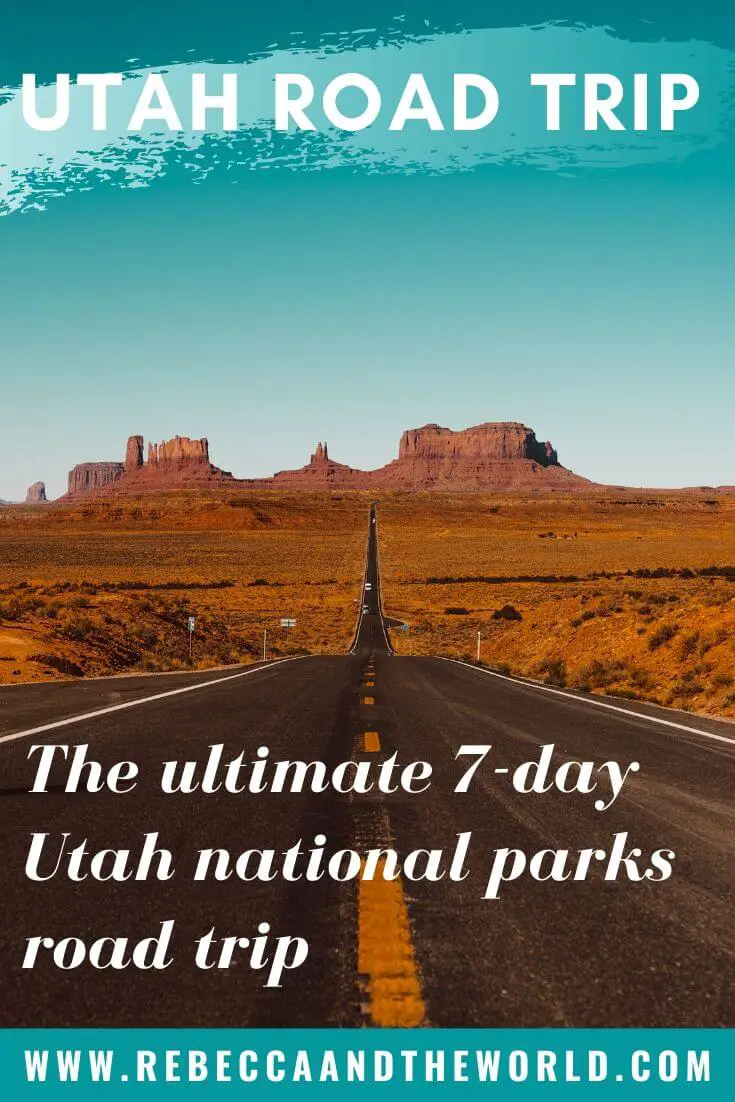
About REBECCA
I'm a travel junkie who started dreaming about seeing the world from a very young age. I've visited more than 40 countries and have a Master of International Sustainable Tourism Management. A former expat, I've lived in Australia, Papua New Guinea, Argentina and the United States. I share travel resources, tips and stories based on my personal experiences, and my goal is to make travel planning just that bit easier.
17 thoughts on “Utah National Parks Road Trip Itinerary: How to Plan a 7-Day Trip to the Mighty 5 in 2024”
Hi Rebecca, I am looking to do a SLC to LV of the Mighty 5 plus GC, Horseshoe Bend, and Antelope Canyon in October. I have 15 days including fly days. Ideas on an itinerary? Thanks so much!
Hi Amy! You could do something like: Salt Lake City (spend a day there if you haven’t already visited), then Bryce Canyon, Capitol Reef, Moab (for both Arches and Canyonlands National Parks), The Needles portion of Canyonlands, Monument Valley, Grand Canyon, Antelope Canyon, Zion, LV. Plan to spend 2 days at least in each of Bryce, GC and Zion, plus 3 days in Moab. That should stretch you out to two weeks without feeling rushed. I’m jealous you’ll have so much time exploring this beautiful part of the world!
Hi…I love this post but I am looking to do LV to LV including a brief visit at GC, Antelope and Horseshoe and then travel on to the Utah parks. I have 10 days including flying. Any ideas on an itinerary?
Hi Joan, how fun! The most efficient route, then, would be Las Vegas – Grand Canyon – Horseshoe Bend/Antelope Canyon – Arches NP/Canyonlands – Capitol Reef – Bryce Canyon – Zion NP – Las Vegas. You could easily do that in 10 days, with one day at each stop (or two days in places you really want to spend a bit more time in). Have fun!!
Dynamite photos, loved looking at them.
Thanks! It’s such a beautiful state, so fun to drive around.
Enjoyed reading this very much. Thanks! Since you did a fair amount of driving around where I’m planning to go, wondering if you had any info/advice to share about using an RV for this trip in the winter. Curious about accessibility with the roads, whether any of the segments between parks make driving difficult because of vehicle clearance, or whether the roads are not paved and may be difficult to traverse in a larger vehicle.
Hey Patrick! So excited that you’re heading this way – it’s a beautiful part of the world. We visited in early June and had no issues with the roads – and there were so many RVs out as well. In winter, I’d say it’d be much the same. The roads between all the parks are paved and well-maintained. Even within the parks the roads are really good so I wouldn’t think you’d have any issues. The only limitation I can see is if you want to get offroad at any time. For example, driving through Monument Valley was quite bumpy in our small campervan, and it might be tough in an RV (depending on how big it is) – check first whether they even allow RVs inside the monument. Happy travelling and let me know if you have any more questions!
Just got back from Zion, but I want to see them all!
What I loved about all the parks in Utah is just how close they were to each other – so it is possible to see several in just a few days!
Such incredible photos – Zion National Park looks like a different planet!! What an adventure – definintely one for the bucketlist!
Absolutely! Was such a great trip 🙂
Rebecca!! Seriously, I cannot thank you enough for opening my eyes to the world of camper vans! We leave in two weeks and last minute Chase wanted to camp (and we pretty much have no camp supplies, although it’s been on my list to get for this summer – to start small and camp close to home LOL, he was ready for a 3000 mile away camp trip), so it left us scrambling to figure out how to get a tent on a plane, oh and then buying a tent, and yadda! We already reserved a rental car, but believe we are returning it and going with the camper van. This post made me even more excited!
Thank you again! <3
Oh I’m so glad I saw your post and commented. It really does make life easier – you don’t have to lug a whole lot of stuff on to a plane, and buy stuff that you might not use again. It will be a bit cold while you’re there, too, so sleeping inside a van will make it a little warmer. Have so much fun – can’t wait to see your pics!!
This post reminds me of your adventure to see Mt Fitz Roy in Patagonia for you took some really great shots at both places! Weather plays an important role in making an outdoor adventure pleasant or not, and you seem to always know when to go. I have to say your photos of those national parks in Utah are some of the best I’ve ever stumbled upon! Btw, in that photo of you and other hikers wading through the icy water at the start of The Narrows, it’s not easy to spot which one your husband is. That bird of paradise reminds me of the days when you were still living in PNG. 🙂
Bama, you always leave the nicest comments!! This really brightened up my day when I first read it and I was in a slump about blogging in general. Thank you! And the fact that you noticed the bird of paradise tattoo! 🙂
Wow Rebecca this is a wonderful blog. I have really enjoyed reading it and will read the others. Elly just told me about it. Glad she did as it gives me an heads up on how you and Matt spend your rec time. Great stuff.
Leave a Comment Cancel reply
MORE INFORMATION
ABOUT WORK WITH ME CONTACT PUBLISHED WORK
AFFILIATE DISCLOSURE
AS AN AMAZON ASSOCIATE I EARN FROM QUALIFYING PURCHASES
© 2024 REBECCA AND THE WORLD
Privacy Policy
I ACKNOWLEDGE THE WURUNDJERI AND BOON WURRUNG PEOPLE OF THE KULIN NATION AS THE TRADITIONAL OWNERS OF THE LANDS AND WATERWAYS OF THE AREA I LIVE ON. I PAY MY RESPECTS TO ELDERS PAST AND PRESENT AND CELEBRATE THE STORIES, CULTURE AND TRADITIONS OF ALL ABORIGINAL AND TORRES STRAIT ISLANDER PEOPLE ACROSS AUSTRALIA.

- Privacy Overview
- Strictly Necessary Cookies
This website uses cookies so that we can provide you with the best user experience possible. Cookie information is stored in your browser and performs functions such as recognising you when you return to our website and helping our team to understand which sections of the website you find most interesting and useful.
Strictly Necessary Cookie should be enabled at all times so that we can save your preferences for cookie settings.
If you disable this cookie, we will not be able to save your preferences. This means that every time you visit this website you will need to enable or disable cookies again.

The Ultimate 10-Day Utah Road Trip Itinerary | Best Utah National Parks Road Trip (2024)
- Last Updated: February 4, 2024
Plan the ultimate Utah road trip with our 10-day itinerary that will take you through all 5 Utah National Parks and leave you ready to return for another adventure!
There’s an inescapable allure to the open road, and nowhere does it beckon more enchantingly than the dusty trails and expansive landscapes of Utah’s five extraordinary National Parks, better known as the “Mighty Five.”
Welcome to an odyssey filled with towering red-rock monoliths, deep winding canyons, and the symphony of the winds dancing around ancient stone arches.
As you buckle up and hit the road, expect to be humbled by the grandeur of Arches, awed by the wild backcountry of Canyonlands, enamored by the lush woodland haven of Capitol Reef, entranced by the unique geological wonders of Bryce Canyon, and blown away by the raw magnificence of Zion.
Each park is a world unto itself, unique in its geological formations, yet united in their haunting beauty.
Get ready to wear yourself out hiking, enjoying the warm sun on your skin and the occasional rush of cool canyon breezes.
This is a journey of discovery, exploration, and most importantly, immense fun. So sit back, relax, and enjoy the ride – our Utah National Parks road trip starts now!
READ MORE: Check out our full guide to the best things to do in Salt Lake City !
Table of Contents
Beginning in Las Vegas
Beginning in salt lake city, how much time is needed to see the utah national parks, when is the best time of year to visit utah’s national parks, rving through the 5 utah national parks, book (everything) in advance, america the beautiful national park pass, pack in layers, start early, nearby hotels – springdale, rv campgrounds in zion national park, what to see and do in zion national park, if you have more time in zion national park, nearby hotels, rv campgrounds in bryce canyon national park, what to see and do in bryce canyon national park, if you have more time in bryce canyon national park, nearby hotels – torrey, rv campgrounds in capitol reef national park, what to see and do in capitol reef national park, if you have more time in capitol reef national park, nearby hotels – moab, rv campgrounds in arches national park, what to see and do in arches national park, if you have more time in arches national park, what to see and do in canyonlands national park, if you have more time in canyonlands national park, rv campgrounds in canyonlands national park, returning to salt lake city, returning to las vegas, continuing on your road trip, southern utah, central and northern utah, wrapping up your utah national parks itinerary, the ultimate utah national parks road trip.
Utah is an outdoor enthusiast’s dream. And whether you plan to stay for each of our recommended ten days or want to extend the road trip, know that you are in for one of the most hyper-scenic experiences in America.
We’ll cover all of the best places to visit and things to do in each of the 5 national parks.
But even the drive between national parks merits time of its own to enjoy the scenery along the way.
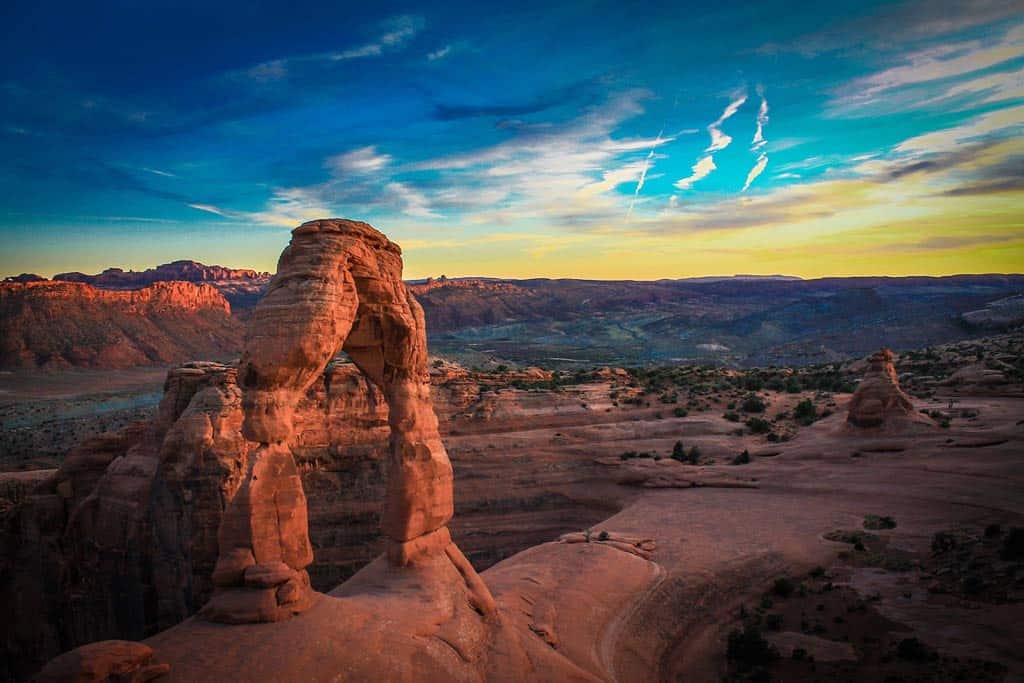
The Best Route Through the Utah National Parks
Although you can begin and end this Utah National Parks road trip on either end of our suggested itinerary, we recommend that you begin in Zion National Park and end at either Canyonlands National Park or Arches National Park, both located just outside of Moab.
To reach Zion National Park you can begin at either Las Vegas with all its crazy things to do, or Salt Lake City.
The best place to begin this epic Utah road trip is by starting in Las Vegas. This will give you the shortest distance to reach Zion National Park, at just over 2 hours of driving along Interstate 15.
Traveling from Las Vegas will also give you plenty of opportunities to take some side trips to amazing places like Lake Mead National Recreational Area, Valley of Fire State Park and the open country of Northern Arizona and Southern Utah where you could even add on a stop at the Grand Canyon National Park.
However, if you have your return trip planned out of Las Vegas, know that it will take nearly 8 hours to drive from Moab, where you’ll finish this itinerary at either Arches National Park or Canyonlands National Park, back to Las Vegas.
So if you have a roundtrip in and out of Las Vegas, you should consider adding a few extra days to this Utah road trip itinerary and consider stops at Monument Valley in Southern Utah and Grand Canyon National Park, Horseshoe Bend and Antelope Canyon in Northern Arizona as you loop back toward Las Vegas.
Of course, if you are on a long road trip that extends beyond these few days in Utah’s national parks, then you can continue on from Moab into Colorado or carry on further north to explore the more remote and less-visited beauty of Northern Utah, such as Goblin Valley State Park and Dinosaur National Monument.
Have extra time in Las Vegas? Check out our top day trips from the city!
If you want to make a roundtrip road trip through Utah, consider beginning and ending your adventure in Salt Lake City.
Although you’ll have to backtrack south along Interstate 15 for around 4 hours, beginning in Salt Lake City will give you the chance to take your time visiting all the national parks while working your way back toward Salt Lake City.
Salt Lake City has a lot of great things to do in itself. So you could add a few days to this Utah road trip itinerary to spend in Salt Lake City itself.
But if you plan to make the most of this 10-day Utah national parks road trip then you’ll want to hit the road immediately upon arriving in Salt Lake City and head south to begin in Zion National Park.
Of course, you can also follow this road trip itinerary in reverse from Salt Lake City as it is approximately the same driving time from Salt Lake City to Moab, where you can begin your adventure at either Arches National Park or Canyonlands National Park.
Related: Consider heading north into Wyoming to spend time exploring Jackson Hole .
To truly immerse yourself in the grandeur of Utah’s five National Parks, it’s recommended to set aside at least 10-14 days for your road trip.
This timeframe gives you about two to three days in each park, allowing you to savor the park’s iconic spots and venture a bit off the beaten path.
Don’t forget to factor in drive time between parks, ranging from 1.5 to 3 hours, and occasional rest days. This leisurely pace gives you plenty of opportunities to not only appreciate the majestic scenery and diverse ecosystems, but also to try out various activities such as hiking, biking, or stargazing.
However, if you’re pressed for time and simply want to soak in the iconic sights, a minimum of 7-10 days can provide a taste of each park’s unique beauty. Allocate a day or two for each park, with a focus on hitting the main highlights.
While this doesn’t allow as much time for long hikes or exploring the more remote corners, you’ll still witness some of the most breathtaking landscapes the American Southwest has to offer.
We have built this road trip itinerary to span 10 days and consider this the barebones minimum to truly enjoy every scenic drive and all of the great hiking trails you will find along the way.
Ultimately, the best itinerary is the one that aligns with your interests, travel style, and the time you have available. Regardless of how much time you spend, a road trip through Utah’s National Parks is an unforgettable journey of discovery and awe.
It is no longer a secret that Utah houses extraordinary scenery all throughout it. As such, trying to time your road trip around the crowds will be a challenge even if you’re not interested in visiting national parks for more than a day or two.
The best time to visit Utah’s National Parks largely depends on what you’re looking for in your journey. If mild weather, fewer crowds, and a vibrant explosion of colors sound appealing, then spring (April to June) and fall (September to October) are your best bet.
In spring, the parks are painted with wildflowers, and the weather is usually comfortable for exploring. Similarly, in the fall, the parks showcase a dramatic play of autumn hues, and the daytime temperatures are perfect for hiking.
Summer (July to August) in Utah can be intensely hot, with temperatures often reaching over 100°F (38°C) in the daytime. Despite the heat, this is the busiest time at the parks due to the school holidays.
If you plan a summer visit, aim for early morning and late afternoon activities when temperatures are cooler, and be sure to stay hydrated. Summer also brings the advantage of longer daylight hours, giving you more time to explore.
Winter (November to March) presents a different kind of beauty in Utah’s National Parks. While some areas may be closed due to snow, the ones that remain open are truly enchanting, with dustings of snow adding a magical touch to the red rock landscapes. The parks are quiet and peaceful, and lodging can be much cheaper.
If you don’t mind the cold and are adequately prepared, winter can be a unique and serene time to experience Utah’s natural wonders. Whether you’re seeking the vibrant colors of spring, the quiet serenity of winter, or anything in between, Utah’s National Parks are a spectacular destination year-round.
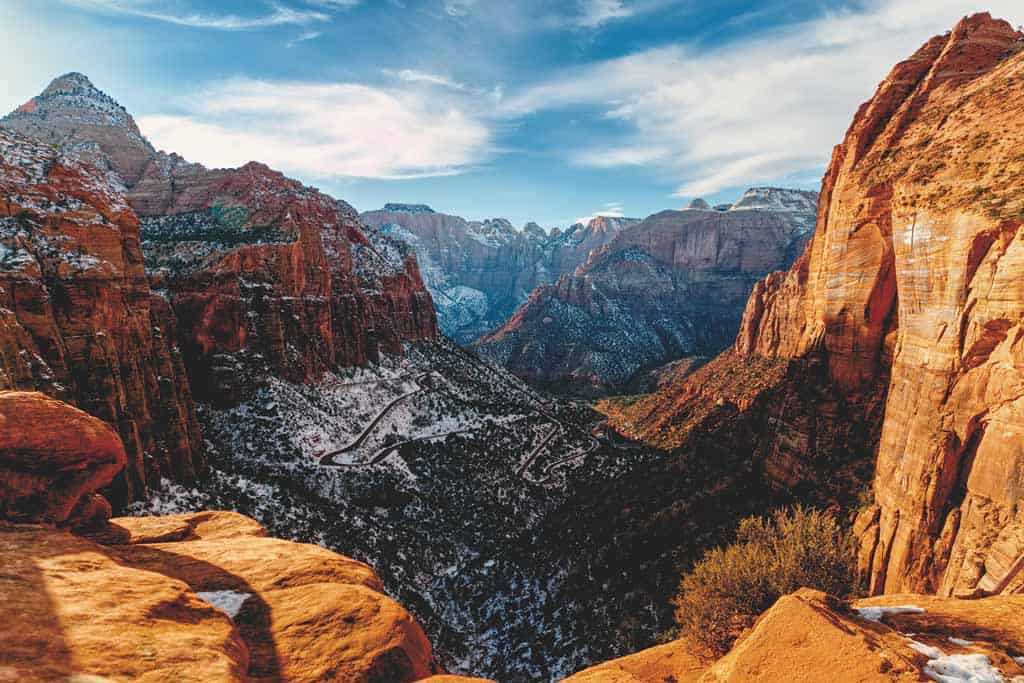
Embarking on an RV journey through Utah’s five magnificent National Parks – Zion, Bryce Canyon, Capitol Reef, Arches, and Canyonlands – is an experience like no other. It allows you to carry the comforts of home while you traverse through mesmerizing landscapes filled with soaring cliffs, fascinating rock formations, sweeping vistas, and brilliant night skies.
The versatility of RV travel offers an all-in-one transportation, dining, and accommodation solution, freeing you from the constraints of hotel check-in times, restaurant reservations, and packing or unpacking at each location.
But do remember that you will still need to book your campground reservations far in advance as this Utah national parks road trip is just as popular with RVers.
But there’s a unique freedom and flexibility that comes with RVing. Instead of rushing to make it to a hotel before nightfall, you can stay out late for stargazing, knowing your comfortable bed is just a few steps away. Early morning hikes become much more accessible when your starting point is in or near the park.
Moreover, an RV’s kitchen facilities mean you have the option to cook your meals, catering to dietary preferences or restrictions and saving you money on dining out.
If you don’t own an RV, fear not, there are numerous rental options available that cater to different needs and budgets. You can conveniently pick up an RV in major cities like Las Vegas or Salt Lake City, both excellent starting points for your Utah National Parks road trip.
Our favorite RV rental company, RVShare , offers a variety of RVs, from compact camper vans perfect for couples to larger motorhomes suitable for families or groups.
Opting for an RV, whether owned or rented, provides an immersive way to experience the captivating beauty of Utah’s National Parks while enjoying the convenience and comfort of having your accommodations on wheels.
Related: Don’t forget to spend some extra time in the adventurous town of Moab !
Tips For Planning A Utah Road Trip
You won’t be the only one planning your epic Utah national parks road trip. But if you plan it right, you can make the most of your time there. These are our best tips for helping you to enjoy your road trip.
Planning a road trip through Utah’s five National Parks is an exciting endeavor, but it’s crucial to book your travel arrangements well in advance. These parks are immensely popular and accommodations, whether you’re opting for campgrounds, RV parks, or nearby hotels, tend to fill up quickly, especially during peak seasons.
The same applies to guided tours , which can offer invaluable insights into the parks’ geology, history, and ecosystems. By booking ahead, you not only secure a place to rest after a day of exploration, but you also avoid the stress of last-minute planning.
Additionally, some parks require advanced permits for specific hikes or activities, so early planning ensures you won’t miss out on these unique experiences. Remember, a well-planned journey paves the way for a relaxed and fulfilling adventure amidst Utah’s stunning landscapes.
If your travel itinerary includes the spectacular quintet of Utah’s National Parks, purchasing the America the Beautiful National Park Pass is not only cost-effective but also convenient. Each individual park has an entrance fee, ranging from $20 to $35.
The American the Beautiful Pass, priced at $80, covers entrance fees at national parks and national wildlife refuges, as well as day-use fees at national forests and grasslands. This means that if you’re visiting three or more parks, the pass quickly pays for itself.
Plus, it eliminates the need to deal with payment at each park entrance, allowing for smoother transitions between your destinations. Keep in mind, the pass is valid for a full year, so any other national parks you decide to visit within that time are essentially free entries.
The America The Beautiful national park pass is an excellent investment for explorers setting their sights on America’s wealth of natural beauty.
Read More: Check out our list of the best day trips from Salt Lake City !
One of the key aspects of a successful trip to Utah’s National Parks is packing and dressing in layers. The state’s desert climate means there can be significant temperature fluctuations between day and night, sometimes exceeding 40 degrees Fahrenheit.
In the peak of summer, days can be scorching hot, while evenings bring a refreshing coolness. On the other hand, winter can see sunny, mild afternoons followed by crisp, chilly nights.
Layering your clothing allows you to easily adjust to these changes and maintain comfort throughout the day. Start with a moisture-wicking base layer to keep you dry, add an insulating middle layer for warmth, and top with water and a wind-resistant outer layer.
Remember, a comfortable explorer is a happy explorer, and the right clothing is essential in making the most out of your Utah National Parks adventure.
Check out our list of hiking tips for more ideas about what to pack and how to plan your adventures!
Starting your activities early when visiting Utah’s National Parks offers several advantages, and it’s a strategy veteran park visitors swear by.
First, you’ll avoid the peak daytime temperatures that can make strenuous activities like hiking not only challenging but potentially dangerous, especially in the summer months.
Second, many popular spots in the parks can get crowded as the day progresses. An early start allows you to beat the crowds, secure parking spaces, and enjoy the tranquil beauty of these natural landscapes at a leisurely pace.
Additionally, the soft morning light provides exceptional opportunities for photography. Lastly, many of Utah’s wildlife are most active during the cooler morning hours, offering a chance to spot and appreciate these creatures in their natural habitat.
So rise before the sun, soak up the serene morning vibes, and get a head start on your day of adventure in Utah’s stunning National Parks.
Utah National Parks Itinerary – Visiting The “Mighty 5”
Utah is hyperscenic. And following our itinerary below will give you the best chance to see and experience a taste of Utah’s national parks that will leave you ready to return to explore more of your favorite places.
We’re beginning this Utah national parks road trip in Las Vegas. But remember, you can swap out Day 1 with a start from Salt Lake City if you find that is better for your overall plans.
Day 1: Las Vegas to Zion National Park
As you leave the neon glow of Las Vegas behind and hit the road toward Zion National Park, prepare for a journey that’s as much about the drive as it is about the destination.
The roughly three-hour drive will take you through an array of landscapes, from the stark beauty of the Mojave Desert to the pastel-colored cliffs of Virgin River Gorge in Arizona.
If you have the time, make sure to stop at the Valley of Fire State Park, an hour’s drive from Las Vegas, which gets its name from the red sandstone formations that look as if they’re on fire when reflecting the sun’s rays.
Here, you can hike, explore ancient petroglyphs, and take stunning photographs of the landscape.
Upon reaching Zion National Park, you’ll find an array of activities to keep you entertained.
You can start with the Scenic Drive, which provides an excellent overview of the park’s main attractions, and the park shuttle makes it easy to hop on and off at different points.
We don’t recommend that you do too much on this first day as you will have plenty of time to explore Zion National Park the following day.
But simply driving through Zion National Park will give you an overview of the splendor and beauty of the area and set you up for what to expect from the other Utah national parks.
If you’re staying in the park, be sure to arrive at your accommodations early on this first night. This will give you time to set up and enjoy an incredible star-filled night .
But perhaps even more importantly, it will allow you to get a good night’s sleep so that you can plan for a very early start the next day.
Remember, although this is the first national park on your national parks road trip, you are not the only one with the idea to visit Utah national parks.
Get your sleep and be ready for an action-filled day as you explore Zion National Park from one end to the other!
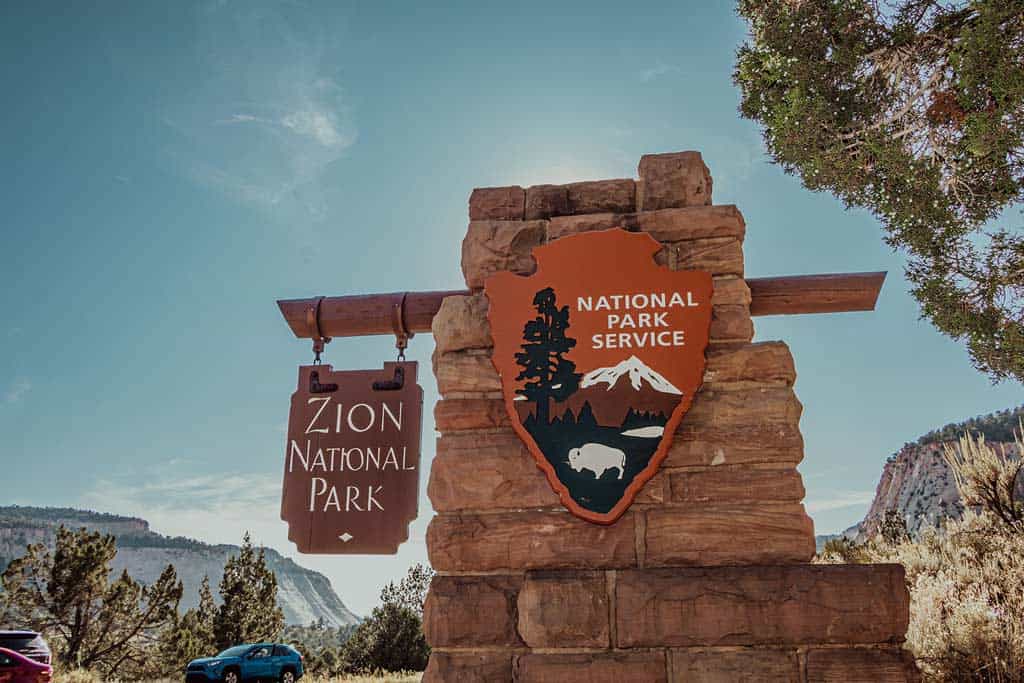
Where to Stay Near Zion National Park
Unless you’ve made arrangements to stay in Zion National Park, the town of Springdale is about as close as you can get to the park. Here are a few great options:
- Pioneer Lodge – This rustic-style lodge offers a range of amenities including a restaurant, an outdoor pool, and easy access to the park, making it a convenient base for visitors eager to explore the stunning landscapes of Zion.
- Holiday Inn Express – Nestled in the majestic red rock cliffs of Zion Canyon, the Holiday Inn Express in Springdale, Utah offers modern amenities and comfortable accommodations. With its outdoor pool, fitness center, complimentary breakfast, and breathtaking views, it serves as a comfortable and convenient hub for travelers exploring the marvels of Zion National Park.
There are a few RV campgrounds in Zion National Park. But these will fill up quickly. So be sure to book as far in advance as possible to ensure that you have a campsite:
- Watchman Campground
- South Campground
Check out this National Park site for information on booking your campsite.
Day 2: Zion National Park
Welcome to Zion National Park, a nature lover’s paradise nestled in the southwestern corner of Utah.
Revered for its impressive sandstone cliffs radiating hues of cream, pink, and red, Zion is a place where landscape meets the sky creating an awe-inspiring backdrop like no other.
The Virgin River, the architect of the park, has carved its way through the rock, sculpting the canyon over millions of years, and creating an oasis of sorts in the desert where diverse plant and animal life thrive.
Zion National Park isn’t just about breathtaking vistas; it’s an invitation for adventures.
With over 200 square miles of exploration, the park offers rugged hiking trails, such as the iconic Angel’s Landing and the narrows of the Virgin River.
It’s a land of discovery, where every corner turned unfolds a scene of stark beauty, a land where one can truly grasp the magnificence of the natural world.
Whether you’re an avid hiker, a wildlife enthusiast, or a casual traveler seeking the serenity that comes with immense natural beauty, Zion is a world-class destination that promises to captivate your spirit.
As a brief overview, here are the top things to see and do in Zion National Park. We’re not telling you where to begin or end.
And some activities may not be suitable for everyone. And you really can’t truly see the park without including at least one Zion National Park Hike.
However, when deciding what to do in Zion National Park, this is our list of the absolute best things to do!
- Angels Landing Hike : This famous hike is not for the faint of heart due to its steep and narrow path, but it provides some of the most breathtaking panoramic views of Zion National Park.
- The Narrows : This unique hike takes you through the narrowest section of Zion Canyon in the Virgin River itself, so be prepared to get a little wet!
- Emerald Pools : This trail leads to a series of picturesque pools and waterfalls. There are both lower and upper trails depending on your preference for difficulty and distance.
- Zion Canyon Scenic Drive : This drive provides stunning views of the park. You can access the park’s shuttle system which stops at multiple points along the route for easy exploration.
- Canyoneering : Zion is known for its excellent canyoneering routes. This adventure sport combines route finding, rappelling, problem-solving, swimming, and hiking.
- Watchman Trail : A relatively easy trail offering impressive views of Zion Canyon, Springdale, and the Watchman Spire.
- Weeping Rock : A short hike that leads you to a rock alcove where water seeps out of the rock, providing a cool respite during hotter months.
- Kolob Canyons : Located in the northwestern section of the park, this area provides a quieter experience with equally stunning canyon views. Don’t miss the Taylor Creek trail.
- Wildlife Watching : Keep an eye out for the park’s abundant wildlife, including mule deer, wild turkeys, and the rare sighting of a bighorn sheep.
- Stargazing : With limited light pollution, the park offers fantastic opportunities for stargazing . Zion regularly offers ranger-led stargazing programs as well.
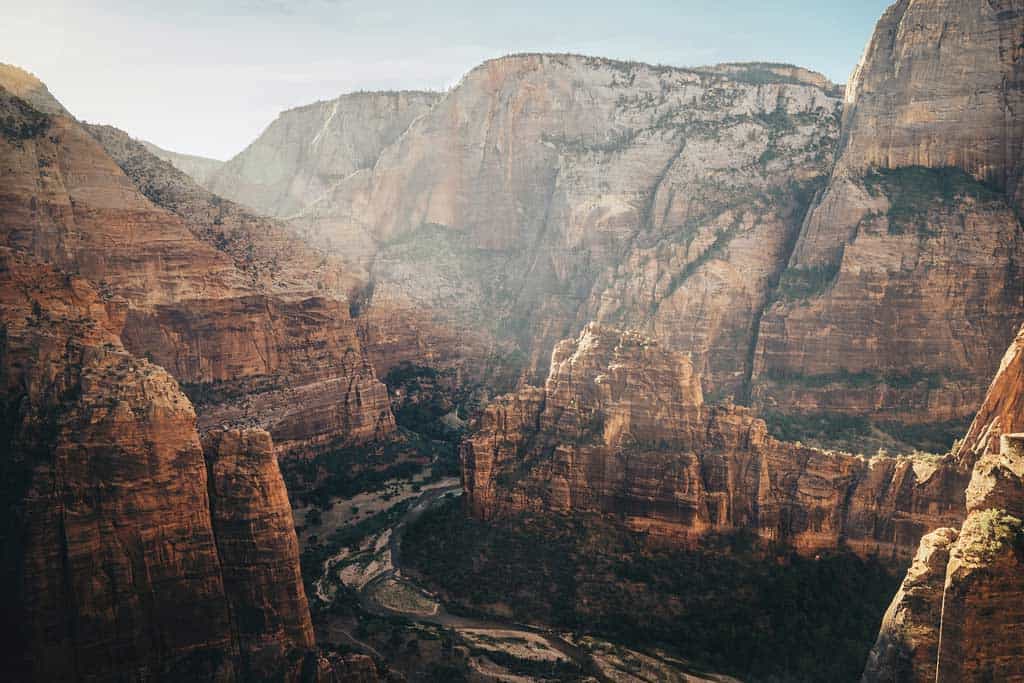
While most of the activities in Zion National Park involve getting out on the hiking trails, there are also some great viewpoints of the national park and a great visitor center where you could spend hours learning about the rock formations that gave rise to such a spectacular place.
Although visitor centers are typically great places to start, unless you stopped by on your first day traveling to Zion National Park, you won’t want to spend too much of your time there as this will eat into your less-busy time exploring the park itself.
If you have additional time in Zion National Park, consider exploring some of the less-trafficked areas of the park.
The Kolob Canyons, a lesser-visited section of the park, provides quieter trails and equally magnificent scenery.
Here, the Taylor Creek Trail is a delightful hike leading to the Double Arch Alcove.
If you’re up for a challenge, try the trail to The Subway, a unique tunnel-shaped canyon and geological marvel, though do note that this requires a permit. Also consider a horseback riding tour of White Mountain for a unique experience!
Alternatively, explore the Zion Human History Museum to learn more about the park’s cultural history or simply find a peaceful spot by the Virgin River and enjoy the serene beauty around you.
If you’re there in the right season, you might even partake in a peaceful bird-watching session, as Zion is home to over 290 species of birds.
Day 3: Zion to Bryce Canyon National Park
Don’t rush away from Zion National Park! Take your time and get one last hike or scenic drive in before heading north toward Bryce Canyon National Park.
The drive to Bryce Canyon National Park from Zion National Park will take a little less than 2 hours… unless you find yourself stopping to take in some of the incredible views along the way.
Taking Highway 9 out of Zion National Park, you’ll travel a few miles east before turning north onto Highway 89, arguably one of the most beautiful stretches of highway in America.
These 43 miles will lead you between the mountains that separate Zion National Park from Bryce Canyon National Park and there are places you may want to pull over to take in views of both.
Depending on how early you arrive in the area, you may want to check into your accommodations and grab a hearty meal to prepare you for a full day of exploring Bryce Canyon National Park.
To reach the park itself, you will turn off Highway 89 and go through a small stretch of hotels , restaurants and tourist shops and attractions in the small towns of Bryce and Bryce Canyon.
If you have time, you can park and take a shuttle through the national park or give yourself a quick self-guided driving tour . Be on the lookout for wildlife in the evening hours.
Remember, while Bryce Canyon National Park is not as popular as Zion National Park or Arches National Park, it is sure to be crowded the next day.
So head to bed early and get your rest so you can wake up early ready to spend a full day exploring the best that the national park has to offer!
Where To Stay Near Bryce Canyon National Park
Most of the accommodations near Bryce Canyon National Park are located in either Bryce, Bryce Canyon City or the town of Tropic.
While Tropic has more hotel offerings, it will require you to backtrack a little to return to the national park the following day.
ere are a few great options for where to stay near Bryce Canyon National Park:
- Best Western PLUS Ruby’s Inn (Bryce Canyon City) – Best Western PLUS Ruby’s Inn, situated just a mile from the entrance of Bryce Canyon National Park, offers cozy accommodations complemented by rustic decor reminiscent of the region’s pioneer heritage. It features a range of amenities including an indoor pool, on-site dining, a general store, and even horse riding activities.
- Bryce Pioneer Village (Tropic, Utah) – Bryce Pioneer Village, located in Tropic, Utah, offers a charming and rustic lodging experience just a short drive from the park. With options for motel rooms or individual cabins set in beautiful gardens, along with amenities like an outdoor pool and an on-site restaurant, it provides a comfortable base for visitors to unwind after a day of exploration.
There are a few RV campgrounds in Bryce Canyon National Park. But these will fill up quickly. So be sure to book as far in advance as possible to ensure that you have a campsite:
- North Campground
- Sunset Campground
Read next: The Ultimate 3 Days In Las Vegas Itinerary
Day 4: Bryce Canyon National Park
Bryce Canyon National Park is a geological wonderland located in southwestern Utah. Not quite a canyon in the traditional sense, Bryce is rather a spectacular series of natural amphitheaters filled with a maze of spire-shaped rock formations called hoodoos.
These towering limestone sculptures, painted in shades of pink, orange, and white, stand tall against a crisp blue sky, creating a whimsical landscape that appears to be more fantasy than reality.
The magic of Bryce Canyon extends beyond its otherworldly daytime views. Designated as a Dark Sky Park, Bryce offers one of the best celestial displays in the country once the sun sets.
Trails for every level, from the relatively easy Navajo Loop to the more strenuous Peekaboo Loop, lead visitors into the heart of the hoodoos, promising an intimate encounter with the park’s unique geology.
Whether you’re there to watch the sun cast its first light on the hoodoos or to gaze upon the star-studded sky, Bryce Canyon National Park is a place that both humbles and inspires with its majestic natural beauty.
As a brief overview, here are the top things to see and do in Bryce Canyon National Park. As with other Utah national parks, we’re not telling you where to begin or end.
And some activities may not be suitable for everyone. However, when deciding what to do in Bryce Canyon National Park, this is our list of the absolute best things to do!
- Sunrise/Sunset Point : Witness the breathtaking sight of the hoodoos glowing in the soft light of sunrise or sunset at this viewpoint.
- Hiking the Navajo Loop Trail : This popular trail descends from Sunset Point through the slot canyon of Wall Street and the Silent City formations.
- Bryce Point : Famous for its extraordinary sunrises, panoramic views of the Bryce Amphitheater can be seen from this point.
- Ride the Scenic Drive : A 38-mile round trip drive with over a dozen viewpoints to pull over and admire the park’s stunning landscapes. Or explore by ATV for an adventurous twist!
- Hike the Rim Trail : This relatively easy trail offers some of the best views of the park and can be hiked in sections.
- Peek-A-Boo Loop : A longer and more strenuous hike that offers stunning views of the park’s iconic hoodoos.
- Visit Mossy Cave : A less-visited part of the park where you can see a waterfall, a mossy overhang that’s cool even in summer, and hoodoos up close.
- Stargazing : Bryce Canyon has some of the darkest night skies in North America, making it an excellent place for stargazing.
- Horseback Riding : Experience the park’s trails from a new perspective with a guided horseback riding tour .
- Winter Sports : In the winter, the park offers cross-country skiing and snowshoeing for a different view of Bryce’s spectacular hoodoos.
If you find yourself with some extra time in Bryce Canyon National Park, consider venturing into the lesser-visited areas of the park. The Fairyland Loop Trail is a longer and less crowded trail that offers fantastic views of the hoodoos, towers, and walls for which Bryce Canyon is famous.
You could also explore the Bristlecone Loop that takes you to Yovimpa Point and Rainbow Point, the highest points in the park, with views extending over 100 miles on clear days.
Another option is to spend a leisurely afternoon horseback riding through the park’s canyon trails, soaking up the unique geological wonders around you.
And, if your visit falls during a new moon, don’t miss one of the ranger-led Full Moon Hikes or a guided astronomy program, as Bryce Canyon is renowned for its clear, dark skies, perfect for stargazing.
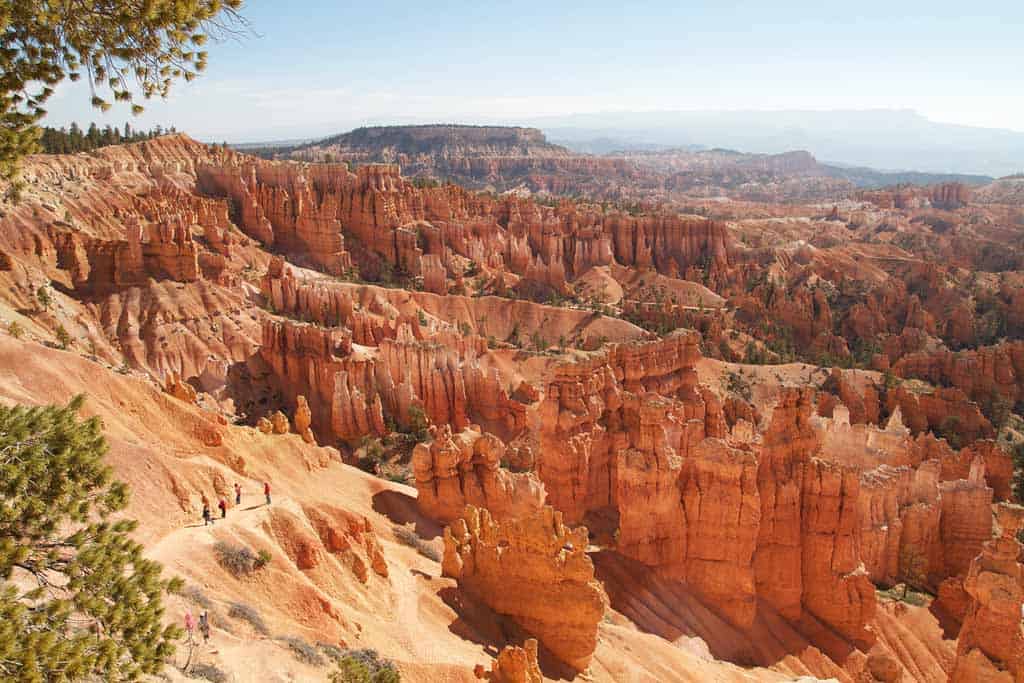
Day 5: Bryce Canyon to Capitol Reef National Park
Don’t rush away from Bryce Canyon National Park! Take your time and get one last hike or scenic drive in before heading north toward Capitol Reef National Park.
The scenic drive to Capitol Reef National Park will take approximately 3 hours. But with the cute little town of Escalante positioned right in the middle of the road trip, plus all of the beauty around, you may want to give it more time.
There are some great slot canyons to hike just north of Escalante if you enjoy finding yourself wedged between sandstone layers of rock that stretch upwards toward the sky.
Take a side trip down the dirt road (sometimes graded) on Hole In The Rock Road to visit Zebra Slot Canyon and Peekaboo Slot Canyon.
Both offer the opportunity to enjoy some open-country hiking that leads into the narrow slot canyons.
Depending on the time of day and season, you may find yourself slogging through water in either canyon and the opportunity always exists to do a little amateur rock climbing as you work your way further back into each canyon.
Zebra Slot Canyon doesn’t require any technical climbing skills. But to see the famed “zebra stripes” in the canyon you’ll want to do some scuttling up and through some very narrow slots.
Be sure to arrive at your accommodations with plenty of time to enjoy the evening. Pick up food in Escalante, or give yourself enough time to cook a meal in your RV if you’re traveling in one.
Then catch some great shut-eye before heading out into Capitol Reef National Park for a full day of adventure the next morning.
If you’re a night owl, you may consider stepping outside after sunset to take in the many stars that blanket the sky.
It’s likely that you’ll be able to very clearly see the Milky Way Galaxy with your bare eyes, depending on the season and timing.
Where To Stay Near Capitol Reef National Park
Your options for staying near Capitol Reef National Park are limited with most of the accommodation options being in the small town of Torrey, Utah, just a 15-minute drive to the national park entrance.
There are other options that lie further west away from the park. So we’d recommend considering the following options when it comes to where to stay near Capitol Reef National Park.
Both are highly rated and we think you’ll appreciate all they have to offer in addition to their proximity to the national park.
- Broken Spur Inn and Steakhouse – Located in the heart of Torrey, Utah, the Broken Spur Inn and Steakhouse offers comfortable lodging and an on-site steakhouse, ensuring guests enjoy not only scenic views of Capitol Reef National Park but also satisfying meals before or after a day of exploration.
- Skyview Hotel – Skyview Hotel in Torrey, Utah, pairs modern comforts with breathtaking views of the red cliffs and canyons of Capitol Reef National Park. Enjoy the pleasant charm and nice amenities such as a heated outdoor pool and a spacious picnic area.
In Capitol Reef National Park there is only one campground and it is likely to fill up quickly due to the remote nature of the campsite. Be sure to book far in advance to ensure that you have a campsite:
- Fruita Campground
Day 6: Capitol Reef National Park
Welcome to Capitol Reef National Park, an enchanting realm nestled in the heart of Utah’s red rock country.
Named for its white domes of Navajo Sandstone that resemble the U.S. Capitol building, and the water pocket fold, a ‘reef’-like geologic wrinkle extending nearly 100 miles, Capitol Reef is a dazzling display of colorful cliffs, massive domes, soaring spires, and twisting canyons.
The park’s unique geologic features tell a story of ancient environments, from lush tropical forests to arid deserts, that existed here millions of years ago.
Venturing into Capitol Reef is like stepping back in time. The park is home to the historic Fruita Rural Historic District, where lush orchards and rustic buildings offer a glimpse of the area’s pioneer heritage.
The rich human history, dating back to the ancient Fremont people, is inscribed on the sandstone cliffs in the form of petroglyphs, a silent testament to the park’s past inhabitants.
Whether you’re exploring its scenic byways, hiking through its dramatic landscapes, or picking fresh fruit in one of the maintained orchards, Capitol Reef National Park offers an unforgettable journey into a lesser-known, but equally captivating, corner of Utah’s impressive national park system.
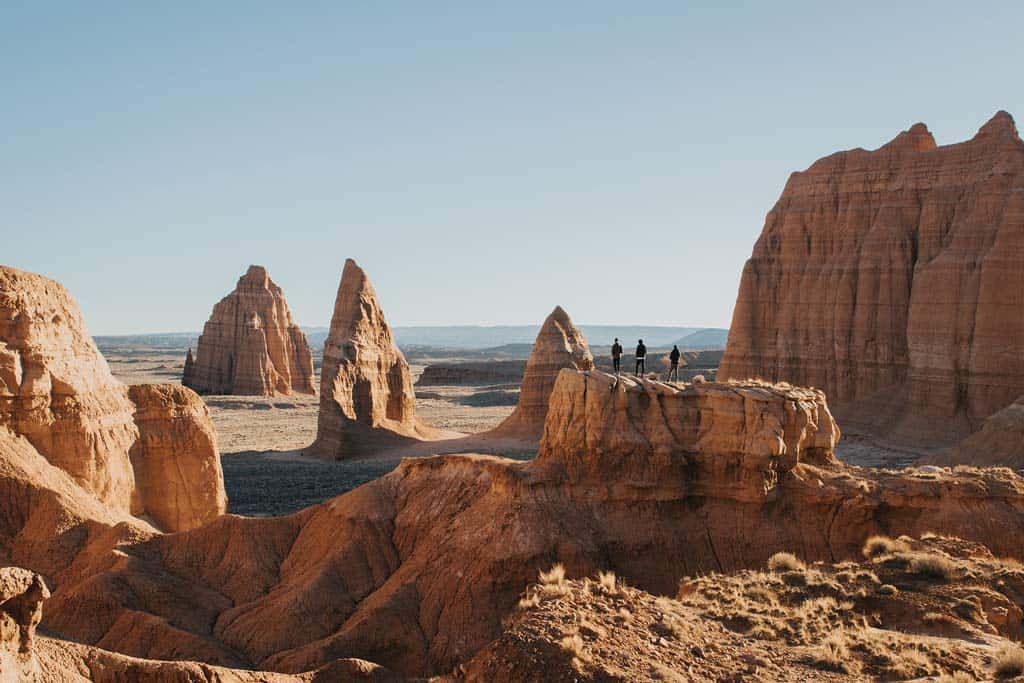
As a brief overview, here are the top things to see and do in Capitol Reef National Park. As with other Utah national parks, we’re not telling you where to begin or end.
And some activities may not be suitable for everyone. However, when deciding what to do in Capitol Reef National Park, this is our list of the absolute best things to do!
- Scenic Drive : A 25-mile round trip that takes you through the heart of the park’s Waterpocket Fold, offering magnificent views of cliffs, canyons, domes, and bridges.
- Hickman Bridge Trail : This moderate trail leads to the impressive Hickman Natural Bridge, one of the largest in the park.
- Fruita Historic District : Explore this old Mormon settlement with its charming orchards where you can pick fruit in season, a historic schoolhouse, and the Gifford Homestead which sells locally made pies and breads.
- Cassidy Arch : A strenuous hike leading to a large, spectacular natural arch named after the famous outlaw Butch Cassidy.
- Petroglyphs : Just east of the Fruita oasis, view petroglyphs inscribed in sandstone by Native Americans of the Fremont Culture.
- Cathedral Valley : A remote, less visited area of the park, featuring stunning monolithic sandstone formations.
- Sulphur Creek Route : A water hike through a narrow canyon, featuring three waterfalls to bypass. Best done in warmer weather.
- Chimney Rock Loop : A moderately difficult trail offering panoramic views of the Waterpocket Fold and the surrounding area.
- Goosenecks Overlook : A short walk to a viewpoint where you can see the deep, dramatic meanders of Sulphur Creek.
- Stargazing : Like many of Utah’s national parks, Capitol Reef offers incredible stargazing due to its status as an International Dark Sky Park.
With some extra time at Capitol Reef National Park, diving deeper into its hidden treasures can make your visit even more unforgettable. A great way to start is by exploring the Cathedral Valley, a less frequented but equally breathtaking region of the park, known for its monolithic formations.
If you’re an avid hiker, consider the strenuous but rewarding Upper Muley Twist Canyon trail, which offers some of the most spectacular panoramic views in the park.
Take a step back in time by visiting the old Fruita Schoolhouse, a one-room building that served the small community from the 1890s to the 1940s.
If you’re visiting during the right season, don’t miss the chance to pick some fruit in the historic Fruita orchards, a unique experience that harks back to the area’s pioneer past.
Looking for more epic road trips? Check out our guide to driving from Las Vegas to Los Angeles !
Day 7: Drive to Moab for Arches National Park and Canyonlands National Park
Next you’ll be heading north toward Moab, where you’ll encounter the spectacular Arches National Park and Canyonlands National Park.
Moab itself merits a little extra time if you have it. From a quaint downtown area that offers all sorts of places to eat and shop to some side trips to places like Corona Arch just outside of town, the area around Moab is worth the time if you have it.
From Capitol Reef National Park, you’ll drive just under 3 hours to reach Moab. Unfortunately, the backroads of this epic Utah national parks road trip ends for a brief stint on Interstate 70 straddling Green River, Utah before ducking back down on Highway 191.
Arches National Park is just as popular, if not more, than Zion National Park so it’s unlikely that you can enjoy too much with the late afternoon arrival into the area. Instead, use this time to head out toward Corona Arch and enjoy that afternoon or early evening hike instead.
Be sure to check in with your accommodations as soon as you can and get settled in for a quiet night. You’ll want to be ready to wake up early to hit Arches National Park before droves of other people do.
But if you are truly committed, consider waking up well before sunrise to head into the park and hike out to Delicate Arch for sunrise, arguably the most iconic arch in the entire national park.
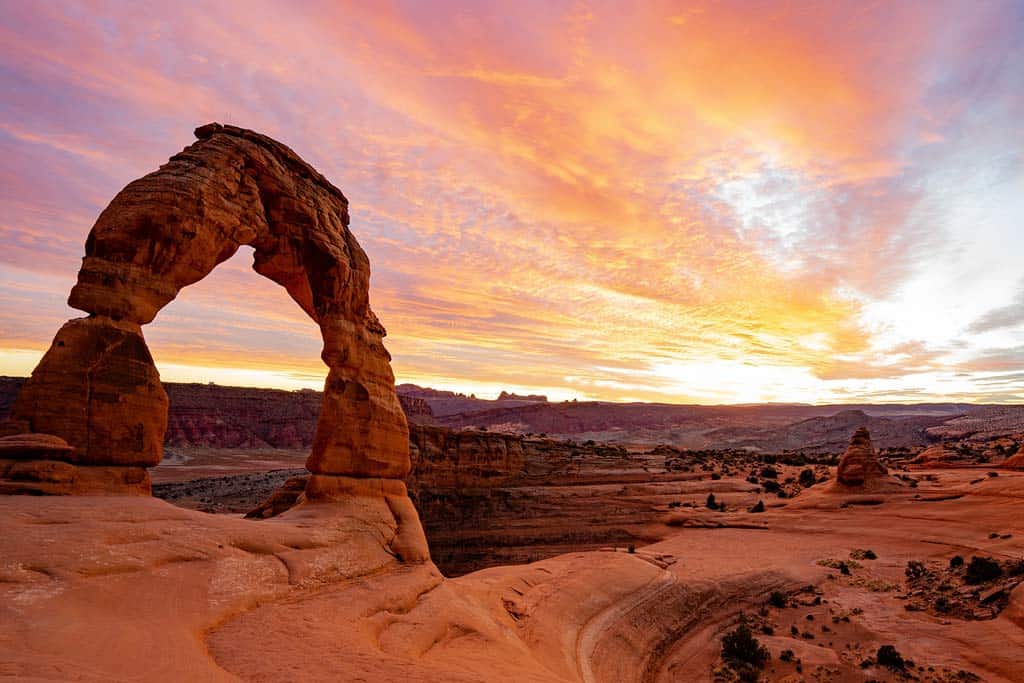
Where to Stay Near Arches National Park
Almost all accommodations for visiting both Arches National Park and Canyonlands National Park will be in and around the small town of Moab. Because Arches National Park is arguably just as busy, if not busier than Zion National Park, the town of Moab has grown up to support a massive influx of visitors and there are ample options for accommodations in the area.
Here are a few of the best options:
- Archway Inn – Complete with an outdoor pool, hot tub, spacious rooms, and a fitness center, this lovely hotel furnished with classy sandstone architecture is a top-rated place to stay near the park.
- Hotel Moab Downtown – Located in the heart of Moab with incredible mountain scenery, this full-service hotel is surrounded by the best restaurants and shops in town. The gorgeous hotel interior doesn’t hurt either!
In Arches National Park there is only one campground and it is likely to fill up quickly due to the popularity of the national park. Be sure to book far in advance to ensure that you have a campsite:
- Devil’s Garden Campground
Day 8: Arches National Park
Arches National Park is a captivating world of stone located in eastern Utah. As the name implies, Arches is a testament to nature’s power and creativity, hosting over 2,000 natural stone arches, the greatest concentration in the world.
These striking formations, along with an array of colossal pinnacles, balanced rocks, and expansive fins, are artfully carved from a vibrant red sandstone landscape, creating a visually stunning panorama that ignites the imagination.
Arches National Park invites visitors to delve into a world where the surreal becomes tangible.
Trails of varying lengths lead you up close to the park’s star attractions, like the Delicate Arch, one of Utah’s most famous icons, or the Landscape Arch, one of the world’s longest.
Whether bathed in the fiery glow of sunrise or sunset, shimmering under the midday sun, or glowing in the soft light of the moon, the arches offer an ever-changing, always mesmerizing spectacle.
Arches National Park is not just a place to see, but a place to savor and experience through adventures like mountain biking , backpacking, ATV driving, and more.
As a brief overview, here are the top things to see and do in Arches National Park. As with other Utah national parks, we’re not telling you where to begin or end.
And this park is PACKED year round, so you may not be able to fully enjoy every experience we have listed.
However, when deciding what to do in Arches National Park, this is our list of the absolute best things to do!
- Delicate Arch Hike : A moderately difficult hike to the park’s most iconic and most photographed natural arch.
- Devils Garden : A network of trails leading to several arches including the Landscape Arch, the longest natural arch in North America.
- Fiery Furnace : A labyrinth of narrow sandstone canyons requiring a permit or a ranger-led tour to explore, to ensure minimal impact on the environment.
- Windows Section : Easy trails that lead to some of the largest arches in the park, including the North and South Window Arches and Turret Arch.
- Park Avenue Trail : This trail provides views of towering sandstone monoliths reminiscent of skyscrapers on a big city street.
- Balanced Rock : One of the park’s most popular features, a massive boulder balanced on a slender pedestal.
- Courthouse Towers : A collection of tall stone columns that showcase the park’s unique geology.
- Double Arch : Two impressive natural arches that share a common end. The trail to reach them is relatively short and easy.
- Sunset at Delicate Arch : A popular activity is to hike to Delicate Arch at sunset to witness the stunning transformation of colors on the rock formations.
- Stargazing : Arches National Park is recognized as an International Dark Sky Park, making it an excellent place for stargazing due to minimal light pollution.
If you’ve budgeted some extra time for exploring Arches National Park, consider delving deeper into its off-the-beaten-path wonders.
The Fiery Furnace, a labyrinth of narrow sandstone canyons, offers a more challenging but rewarding experience – just remember to either join a ranger-led tour or get a permit if you plan to navigate it yourself.
If you’re up for a longer hike, the seven-mile Primitive Loop at Devil’s Garden will reward you with views of some of the park’s less-visited arches.
Consider also a visit to the petroglyphs at Wolfe Ranch to appreciate the history and culture of the park’s earlier inhabitants. Or go stand-up paddleboarding or white-water rafting on the Colorado River if you’re looking for a break from land-based activities!
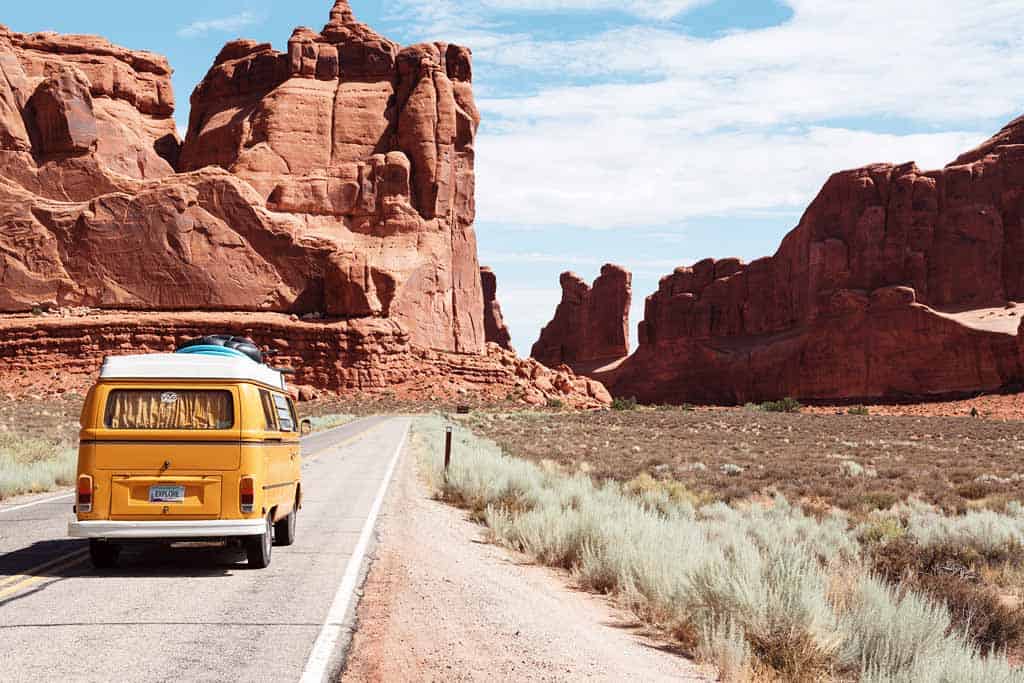
Day 9: Canyonlands National Park
Welcome to Canyonlands National Park, a captivating wonderland located in the heart of southeastern Utah.
Spanning over 337,000 acres, Canyonlands is a vast desert ecosystem sculpted by the Colorado River and its tributaries into a rugged panorama of mesas, canyons, and remarkable rock formations.
The park’s unique geology unfolds millions of years of Earth’s history, with layers of sedimentary rock that document time like pages in a book.
Yet, Canyonlands is more than just a geological showcase; it’s a place where the sheer scale of the landscape and the silence of the desert can create a profoundly stunning experience.
The park’s expanse is divided into four districts – Island in the Sky, The Needles, The Maze, and the rivers themselves – each boasting its own distinctive character and array of outdoor adventures.
Whether you’re standing on the edge of a towering mesa overlooking the winding river canyons, exploring the cryptic messages left by ancient Native American civilizations, or star-gazing in the crystal-clear night skies, Canyonlands offers an exploration into a beautifully rugged and untamed corner of the world.
Canyonlands National Park is a vast wilderness of stark yet breathtaking beauty characterized by its dramatic desert landscapes.
Featuring a diverse array of towering mesas, deep canyons, and the converging Colorado and Green Rivers, the park provides an awe-inspiring panorama that reveals millions of years of geologic history.
Here are a few of the best things to see and do in Canyonlands National Park:
- Island in the Sky : This is the easiest district of the park to access and offers breathtaking views from numerous overlooks along the paved scenic drive.
- Mesa Arch : A short hike leads to this poetically named natural arch, a popular spot for photographers, especially at sunrise.
- White Rim Road : A 100-mile dirt road loops around and below the Island in the Sky mesa, providing spectacular views for those up for a 4WD adventure.
- The Needles : This district offers extensive hiking trails through a landscape punctuated by colorful sandstone spires.
- Horseshoe Canyon : This detached unit of the park is home to the famous Great Gallery, one of the best examples of prehistoric pictographs (rock art) in America.
- Upheaval Dome : Visit this unique geologic feature and decide for yourself whether it was created by a salt dome or a meteor impact.
- Green River Overlook : A popular spot that provides panoramic views of the Green River in the Island in the Sky district.
- Rafting on the Colorado River : Experience the thrill of rafting through the park’s spectacular canyons.
- Elephant Hill Trail : This challenging 4WD trail in the Needles district leads to some of the most remote and beautiful places in the park.
- Stargazing : Canyonlands National Park has been designated a Gold-Tier International Dark Sky Park, making it an exceptional place to stargaze and contemplate the mysteries of the universe.
With additional time at Canyonlands National Park, your adventures can extend beyond the iconic Island in the Sky district.
Consider exploring the more remote Needles district, where colorful sandstone spires tower above extensive hiking trails and large, park-like clearings.
If you’re equipped with a 4WD vehicle, a journey along the White Rim Road will present stunning, up-close views of the park’s complex geology.
Another remarkable but less-visited area is the park’s Maze district, one of the most remote areas in the United States, offering solitude and a maze-like network of canyons to explore.
If you’re keen on prehistoric culture, the Horseshoe Canyon contains some of the most significant rock art in North America, including the breathtaking Great Gallery panel. Just remember, some of these activities require permits, so plan accordingly!
There are a few RV campgrounds in Canyonlands National Park. But these will fill up quickly. So be sure to book as far in advance as possible to ensure that you have a campsite:
- Islands In The Sky (Willow Flat) Campground
- The Needles Campground
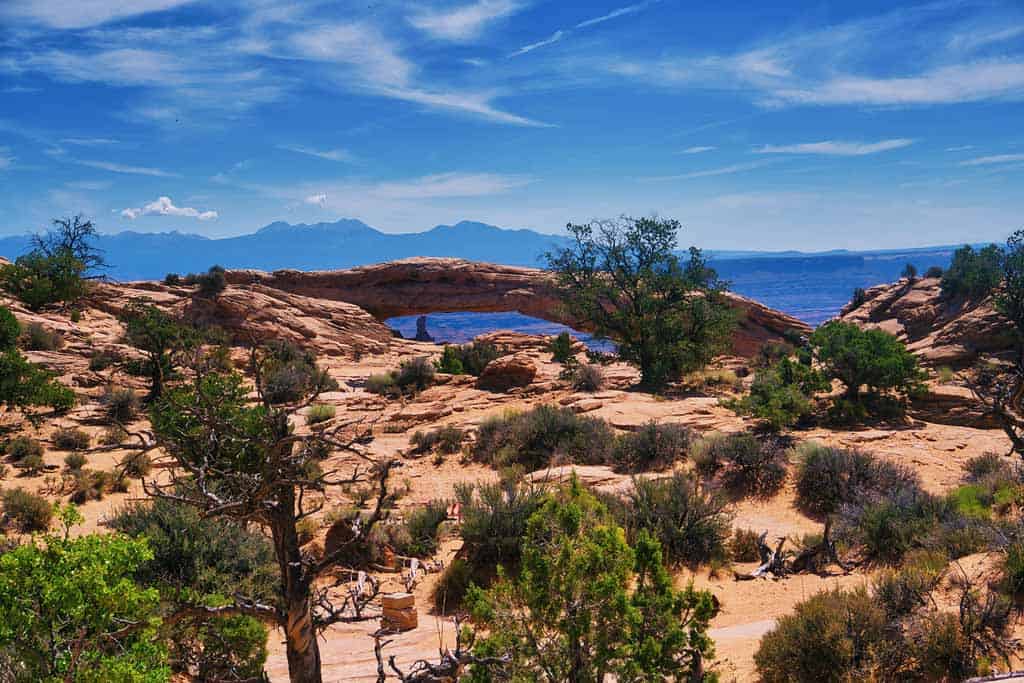
Day 10: Return trip
On the final day of your Utah road trip, you will spend a good portion of it driving back to either Las Vegas or Salt Lake City, depending on your final destination.
Both of these drives can be road trips on their own, with plenty of other stops along the way.
The drive from Moab to Salt Lake City will take approximately 4 hours. This will be mostly along backroad highways that continue to offer the kind of beauty that makes anyone want to visit utah.
Here are a few points of interest along the drive back to Salt Lake City:
- Price Canyon Recreation Area : This is a great spot to stretch your legs and take in the stunning views of the surrounding canyons and plateaus.
- Nine Mile Canyon : Known as the world’s longest art gallery, this canyon contains extensive petroglyphs and pictographs from ancient Native American cultures. It’s a slight detour off the main route, but well worth the extra time for history and archaeology enthusiasts.
- Helper, Utah : This quaint mining town has a charming Main Street with historic buildings, antique shops, and the Western Mining & Railroad Museum.
- Provo River Falls : Nestled in the Uinta National Forest, the Provo River tumbles over a series of scenic waterfalls. There are plenty of spots to picnic and trails to explore.
- Soldier Hollow : This venue was home to cross-country skiing and biathlon events during the 2002 Winter Olympics and now offers year-round outdoor activities. Take a break here to appreciate the beautiful mountain views, and if you’re passing through in winter, enjoy some snow sports.
Driving to Las Vegas from Moab will take around 7 hours and will be primarily along the interstate. You’ll spend much of the time on Interstate 70 until it meets Interstate 15.
If you head along this route and want to split the drive into two days, here are a few points of interest along the way:
- San Rafael Swell : Located near Green River, Utah, this is a large geologic feature known for its scenic sandstone formations, deep canyons, and expansive panoramas.
- Fishlake National Forest : Close to Richfield, Utah, this national forest is home to the Pando, an enormous grove of quaking aspen which is considered the heaviest known living organism.
- Cove Fort : Near Beaver, Utah, this historic site is a well-preserved pioneer-era fort. Guided tours offer insight into life in the 19th century American West.
- Cedar Breaks National Monument : Just off Interstate 15 near Cedar City, Utah, this park offers breathtaking views of a naturally formed amphitheater canyon filled with colorful hoodoos and rock formations.
- Valley of Fire State Park : Nevada’s oldest and largest state park, known for its vibrant red sandstone formations, petrified wood, and ancient petroglyphs. It’s about an hour off the route, but its otherworldly landscapes make it worth the detour.
If you want to take a more scenic route, you can head south out of Moab and follow highway 191 in Utah through Monument Valley and into northern Arizona. This will lead you to Page, Arizona where you can take a detour to visit Grand Canyon National Park, which is worth the detour in our opinion!
From Page you can also see famous landmarks and national monuments such as Horseshoe Bend and Antelope Canyon.
Carry on toward Kanab and take a little detour to hiks some great slot canyons or connect back to Zion National Park for a second visit before returning to Interstate 15 for the short drive back to Las Vegas.
Plan to explore more of Arizona? Check out our list of the best things to do in Tucscon !
If you are continuing on your road trip from Moab, you can easily cross into Colorado and enjoy all that the Centennial State has to offer.
A short 2 hour drive east along Interstate 70 will take you to Grand Junction, where you can decide which direction you want to go to enjoy the beauty of Colorado’s Rocky Mountains.
Of course, road trips in Colorado are a whole other opportunity and the state is well worth exploring over the course of several weeks.
And although not as close as Colorado, you could continue your Utah road trip north and enter remote areas of Wyoming where you’ll come across vast stretches of land that seem to stretch on forever.
This route will put you in Rock Springs, Wyoming and in a direct route toward Grand Teton National Park and the adjoining Yellowstone National Park.
Other Utah Road Trip Destinations
Visiting Utah national parks is a bucket list item of its own. However, if you feel like tacking on a few extra days (or weeks!) on your Utah road trip, then there are some other great destinations nearby that offer great alternatives to Utah’s parks.
Two regions that deserve your attention and do not require too much deviation from this core Utah national parks road trip are in southern utah and northeastern Utah.
If you aren’t in a rush and/or are making your way back to Las Vegas along the scenic Southern Utah route, consider spending a few extra days taking in all of the beauty of this region. Here are a few top places to stop along the way:
- Monument Valley Navajo Tribal Park : This iconic landscape, featuring stunning red sandstone buttes, is located within the Navajo Nation on the border of Utah and Arizona.
- Antelope Canyon : Near Page, Arizona, this mesmerizing slot canyon is renowned for its swirling sandstone walls and ethereal light beams.
- Lake Powell : A reservoir on the Colorado River, straddling the border between Utah and Arizona, this is a prime spot for boating, fishing, and exploring numerous sandstone canyons.
- Glen Canyon National Recreation Area : Encompassing over 1.25 million acres from Arizona to southern Utah, this area offers opportunities for water-based and backcountry activities.
- Coral Pink Sand Dunes State Park : Located in Utah, this park features a stunning expanse of reddish-pink sand dunes that you can explore on foot or with off-road vehicles.
- Horseshoe Bend : Just outside Page, Arizona, this iconic bend in the Colorado River is famous for its dramatic views from the cliff edge.
- Grand Canyon National Park – North Rim : While most visitors head to the South Rim, the North Rim offers a quieter and equally stunning view of this iconic landscape in Arizona.
- Vermilion Cliffs National Monument : Located in Arizona, this area is known for its colorful, undulating rock formations, including the renowned Wave formation in the Paria Canyon-Vermilion Cliffs Wilderness. Remember, visiting The Wave requires a permit obtained through a lottery system.
Read next: 21 Best Things To Do In Phoenix, Arizona
If your Utah road trip continues north from Moab there are some great places that will seem even more remote than any you have seen amonth the Utah national parks itinerary.
Here are a few of those places that can extend your utah road trip a few extra days:
- Dinosaur National Monument : While technically designated a national monument, this area in northeastern Utah is famous for its wealth of dinosaur fossils. The quarry exhibits a wall with over 1,500 dinosaur bones still encased in rock.
- Goblin Valley State Park: Renowned for its thousands of whimsical and eerie sandstone formations, often referred to as goblins, which create a surreal, Goblin Valley State Park offers Mars-like landscape that’s perfect for hiking and exploration.
- Little Wild Horse Canyon: Located near Goblin Valley State Park in Utah, the area is a popular non-technical slot canyon that offers a stunning, family-friendly hike through sculpted sandstone walls where you can day hike or continue on multi-day treks.
- Flaming Gorge National Recreation Area : This beautiful area, featuring a massive dam and reservoir, offers boating, fishing, camping, and plenty of trails with panoramic vistas.
- Uinta-Wasatch-Cache National Forest : The Mirror Lake Scenic Byway runs through this forest, offering stunning views, hiking trails, fishing spots, and campgrounds.
- Steinaker State Park : Located near Vernal, this state park has a reservoir for boating and fishing, along with camping facilities and picnicking spots.
- Utah Field House of Natural History State Park Museum : Also located in Vernal, this museum offers exhibits about the area’s geology and prehistory, including dinosaur fossils.
- Red Fleet State Park : This park offers a reservoir for water activities, hiking trails with dinosaur tracks, and camping facilities.
- Fantasy Canyon : This unique area features one-of-a-kind, small-scale sandstone formations that have been eroded into fantastical shapes, creating an almost otherworldly landscape. It’s off the beaten path but well worth the visit for photography or geology enthusiasts.
Wrapping up our expansive Utah road trip, it’s clear to see why this state’s stunning landscapes have captivated the hearts of travelers worldwide.
From the grandeur of the Mighty 5 national parks, each with their unique charm and attractions, to the countless additional points of interest along our journey – including state parks, monuments, and charming towns – Utah offers an abundance of natural beauty and history that makes it a premier destination for road trippers.
Whether you’re an adventurer seeking the thrill of hiking rugged terrains, a history enthusiast keen on immersing yourself in cultural and geological tales from millennia past, or simply a nature lover wanting to bask in some of the most awe-inspiring landscapes on earth, Utah’s diverse terrain has something for everyone.
Remember, this itinerary is just a guide – take your time, explore off the beaten path, and make your own discoveries. After all, that’s the beauty of a road trip: the journey is just as important as the destination. Safe travels, and enjoy your Utah exploration!
DISCLAIMER: Some of the links in this article are affiliate links, which means if you book accommodation, tours or buy a product, we will receive a small commission at no extra cost to you. These commissions help us keep creating more free travel content to help people plan their holidays and adventures. We only recommend the best accommodations, tours and products that ourselves or our fantastic editorial team have personally experienced, and regularly review these. Thanks for your support, kind friend!
Alesha and Jarryd
Hi, We’re Alesha and Jarryd!

We’ve been traveling the world together since 2008, searching for the planet’s best destinations and adventures.
Love Travel?
Sign up for our free weekly newsletter for the best travel tips, ideas and deals!
We respect your privacy. Unsubscribe at any time.
READ MORE...
17 Best Road Trips From San Francisco, California (2024 Guide)
The Best Los Angeles To Grand Canyon Road Trip (2024 Guide)
11 Best Road Trips From Denver, Colorado (2024 Guide)
Related Posts
The ultimate california pacific coast highway road trip itinerary (2024 guide), 21 best things to do in tampa, florida [2024 guide], sheraton tribeca new york hotel review, 21 best things to do in aspen, colorado (2024 guide), leave a comment cancel reply.
Save my name, email, and website in this browser for the next time I comment.

IMAGES
COMMENTS
Learn how to plan your Utah national parks road trip itinerary and visit Utah's Mighty 5: Zion, Bryce Canyon, Capitol Reef, Arches, and Canyonlands National Parks.
Don’t miss the best of Utah’s national parks on your upcoming trip! This free, printable Utah national park road trip itinerary covers all the best points of interest in all 5 Utah parks, plus bonus tips on where to stay and side trips to nearby state parks and monuments.
Planning a Utah national parks road trip? Check out my 7 day Utah road trip itinerary to visit the Utah Mighty 5 (with printable planner!).
Road Trip Itinerary Map for Utah National Parks. This map shows all the must-see stops on your Utah National Parks road trip. I’ll break down each destination in detail below, giving you tips to make your journey as smooth and enjoyable as possible. Open full screen to view more. This map was created by a user. Learn how to create your own.
Plan the ultimate Utah road trip with our 10-day itinerary that will take you through all 5 Utah national parks and leave you ready to return for another adventure!
In this 10-day Utah Mighty Five road trip itinerary, you’ll canyoneer through slot canyons, ride horses and ATVs, learn about ridiculous pioneer and Mormon history, hike through a river, watch the sunrise over a hoodoo-filled canyon, and catch a sunset through a massive stone arch.